Importance of Talent Management Strategies for Employee Development and Retention in H&M: A Case Study
VerifiedAdded on 2023/06/07
|38
|6331
|179
AI Summary
This research study focuses on the importance of talent management strategies used by line managers and leaders for employee development and retention in H&M. The study aims to understand the concept of talent management practices, examine the strategies adopted by line managers and leaders, and analyze their roles and responsibilities. The study is conducted using quantitative research methodology.
Contribute Materials
Your contribution can guide someone’s learning journey. Share your
documents today.
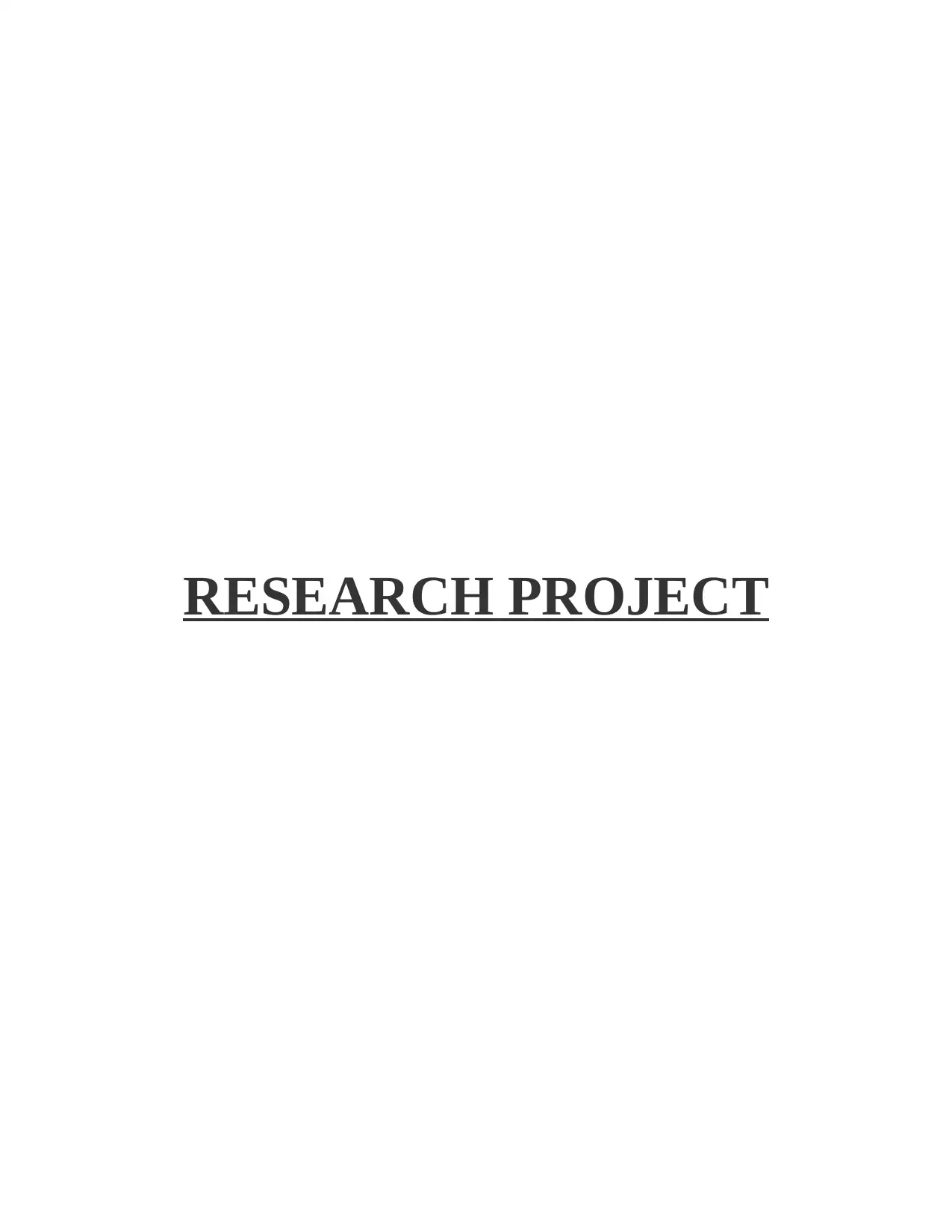
RESEARCH PROJECT
Secure Best Marks with AI Grader
Need help grading? Try our AI Grader for instant feedback on your assignments.
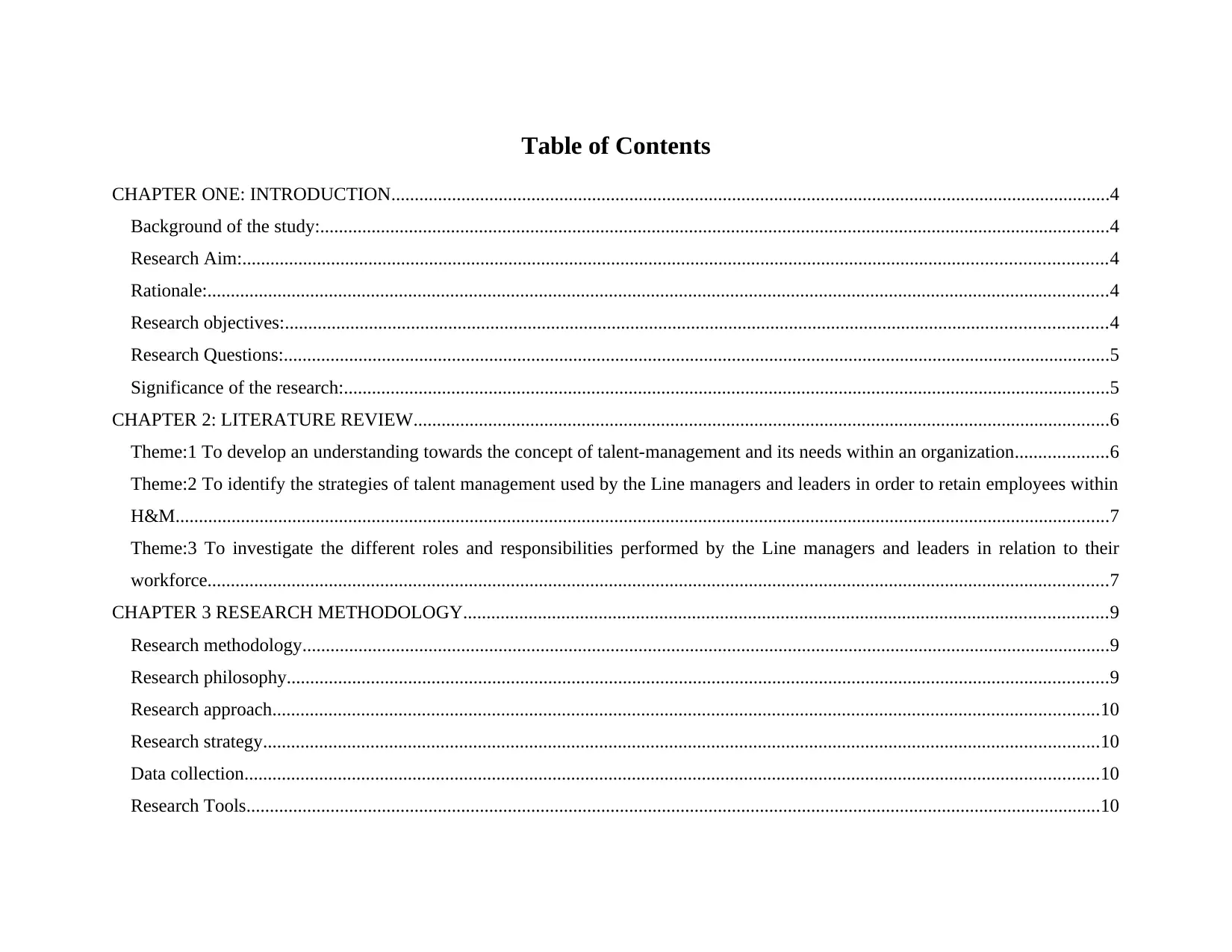
Table of Contents
CHAPTER ONE: INTRODUCTION..........................................................................................................................................................4
Background of the study:.........................................................................................................................................................................4
Research Aim:.........................................................................................................................................................................................4
Rationale:.................................................................................................................................................................................................4
Research objectives:................................................................................................................................................................................4
Research Questions:.................................................................................................................................................................................5
Significance of the research:....................................................................................................................................................................5
CHAPTER 2: LITERATURE REVIEW.....................................................................................................................................................6
Theme:1 To develop an understanding towards the concept of talent-management and its needs within an organization....................6
Theme:2 To identify the strategies of talent management used by the Line managers and leaders in order to retain employees within
H&M........................................................................................................................................................................................................7
Theme:3 To investigate the different roles and responsibilities performed by the Line managers and leaders in relation to their
workforce.................................................................................................................................................................................................7
CHAPTER 3 RESEARCH METHODOLOGY..........................................................................................................................................9
Research methodology.............................................................................................................................................................................9
Research philosophy................................................................................................................................................................................9
Research approach.................................................................................................................................................................................10
Research strategy...................................................................................................................................................................................10
Data collection.......................................................................................................................................................................................10
Research Tools.......................................................................................................................................................................................10
CHAPTER ONE: INTRODUCTION..........................................................................................................................................................4
Background of the study:.........................................................................................................................................................................4
Research Aim:.........................................................................................................................................................................................4
Rationale:.................................................................................................................................................................................................4
Research objectives:................................................................................................................................................................................4
Research Questions:.................................................................................................................................................................................5
Significance of the research:....................................................................................................................................................................5
CHAPTER 2: LITERATURE REVIEW.....................................................................................................................................................6
Theme:1 To develop an understanding towards the concept of talent-management and its needs within an organization....................6
Theme:2 To identify the strategies of talent management used by the Line managers and leaders in order to retain employees within
H&M........................................................................................................................................................................................................7
Theme:3 To investigate the different roles and responsibilities performed by the Line managers and leaders in relation to their
workforce.................................................................................................................................................................................................7
CHAPTER 3 RESEARCH METHODOLOGY..........................................................................................................................................9
Research methodology.............................................................................................................................................................................9
Research philosophy................................................................................................................................................................................9
Research approach.................................................................................................................................................................................10
Research strategy...................................................................................................................................................................................10
Data collection.......................................................................................................................................................................................10
Research Tools.......................................................................................................................................................................................10
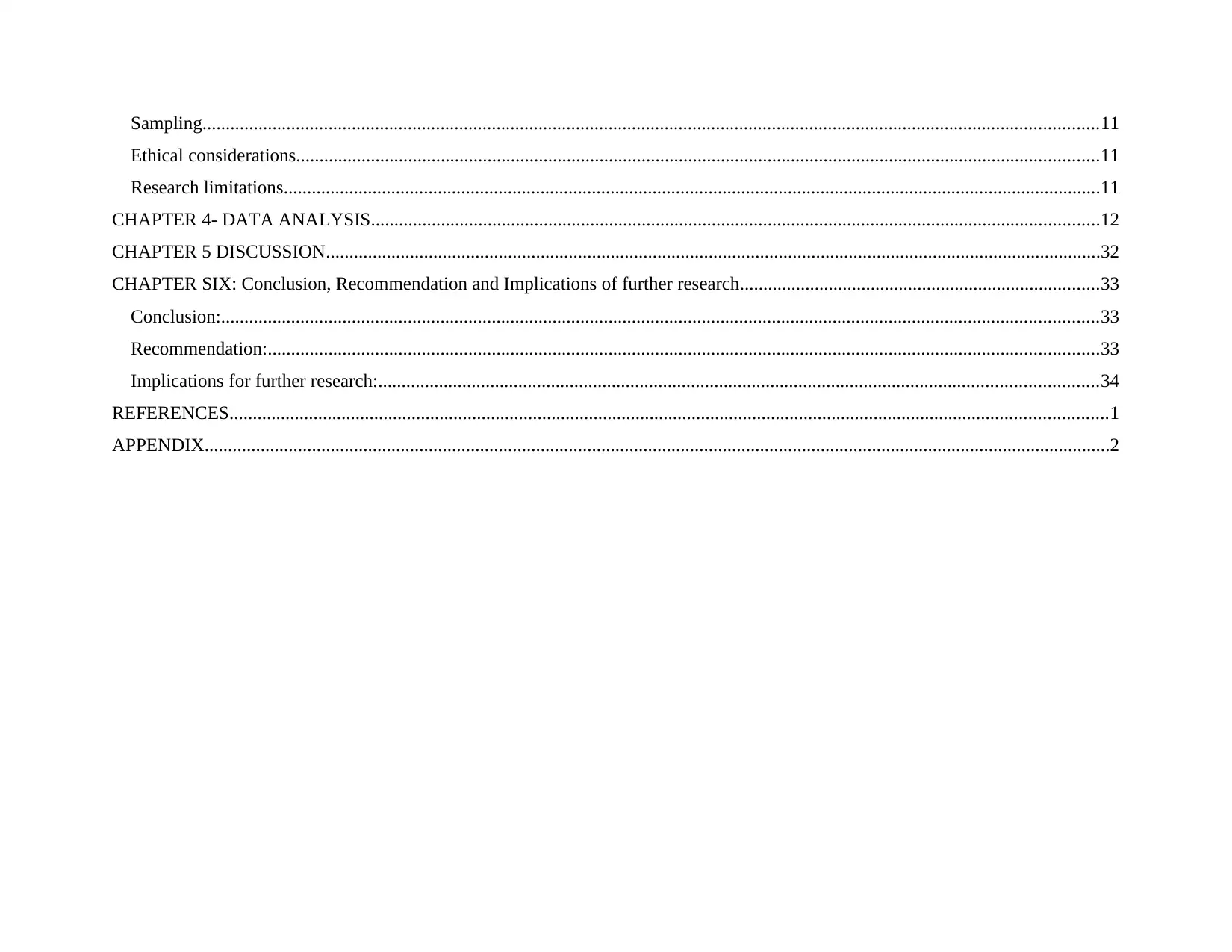
Sampling................................................................................................................................................................................................11
Ethical considerations............................................................................................................................................................................11
Research limitations...............................................................................................................................................................................11
CHAPTER 4- DATA ANALYSIS............................................................................................................................................................12
CHAPTER 5 DISCUSSION......................................................................................................................................................................32
CHAPTER SIX: Conclusion, Recommendation and Implications of further research.............................................................................33
Conclusion:............................................................................................................................................................................................33
Recommendation:..................................................................................................................................................................................33
Implications for further research:..........................................................................................................................................................34
REFERENCES............................................................................................................................................................................................1
APPENDIX..................................................................................................................................................................................................2
Ethical considerations............................................................................................................................................................................11
Research limitations...............................................................................................................................................................................11
CHAPTER 4- DATA ANALYSIS............................................................................................................................................................12
CHAPTER 5 DISCUSSION......................................................................................................................................................................32
CHAPTER SIX: Conclusion, Recommendation and Implications of further research.............................................................................33
Conclusion:............................................................................................................................................................................................33
Recommendation:..................................................................................................................................................................................33
Implications for further research:..........................................................................................................................................................34
REFERENCES............................................................................................................................................................................................1
APPENDIX..................................................................................................................................................................................................2
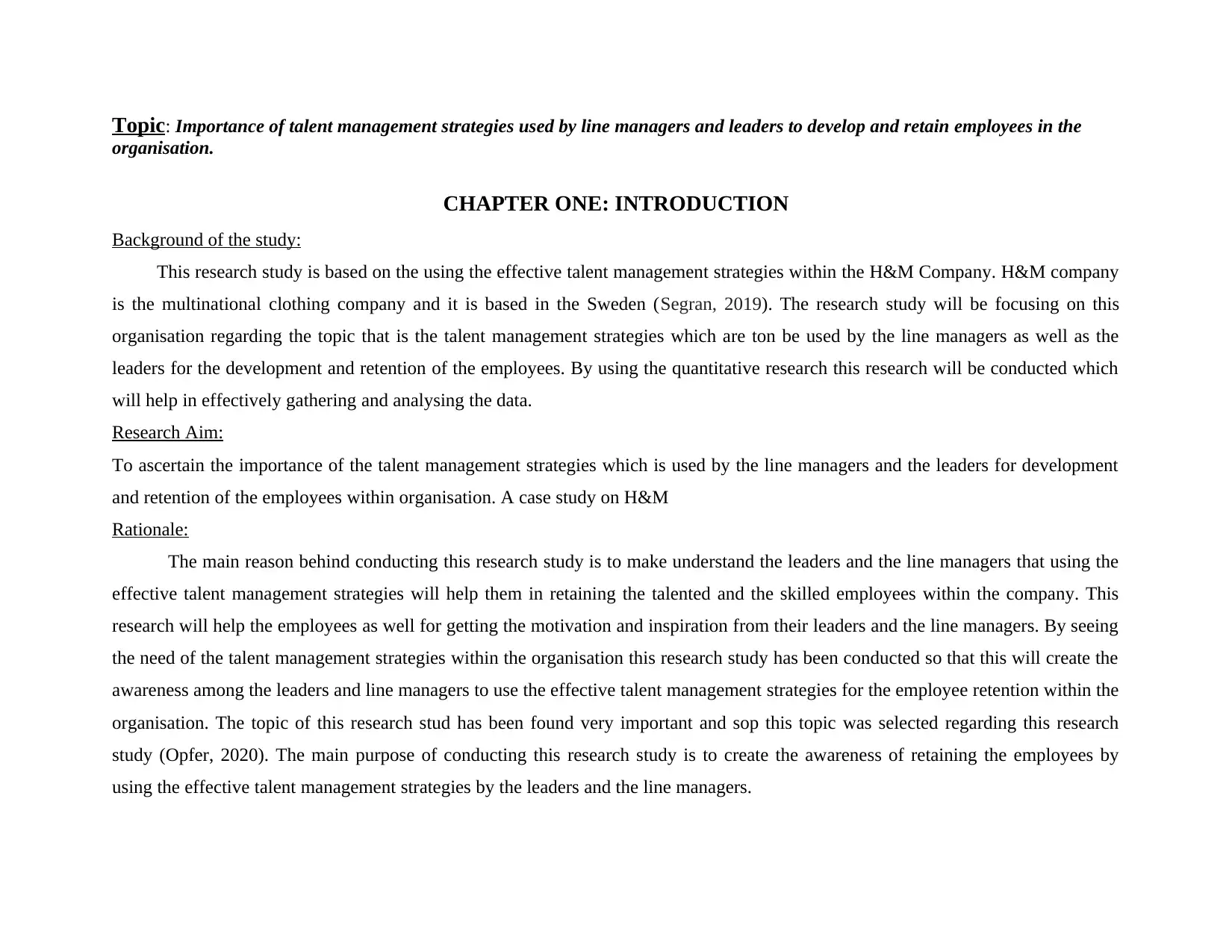
Topic: Importance of talent management strategies used by line managers and leaders to develop and retain employees in the
organisation.
CHAPTER ONE: INTRODUCTION
Background of the study:
This research study is based on the using the effective talent management strategies within the H&M Company. H&M company
is the multinational clothing company and it is based in the Sweden (Segran, 2019). The research study will be focusing on this
organisation regarding the topic that is the talent management strategies which are ton be used by the line managers as well as the
leaders for the development and retention of the employees. By using the quantitative research this research will be conducted which
will help in effectively gathering and analysing the data.
Research Aim:
To ascertain the importance of the talent management strategies which is used by the line managers and the leaders for development
and retention of the employees within organisation. A case study on H&M
Rationale:
The main reason behind conducting this research study is to make understand the leaders and the line managers that using the
effective talent management strategies will help them in retaining the talented and the skilled employees within the company. This
research will help the employees as well for getting the motivation and inspiration from their leaders and the line managers. By seeing
the need of the talent management strategies within the organisation this research study has been conducted so that this will create the
awareness among the leaders and line managers to use the effective talent management strategies for the employee retention within the
organisation. The topic of this research stud has been found very important and sop this topic was selected regarding this research
study (Opfer, 2020). The main purpose of conducting this research study is to create the awareness of retaining the employees by
using the effective talent management strategies by the leaders and the line managers.
organisation.
CHAPTER ONE: INTRODUCTION
Background of the study:
This research study is based on the using the effective talent management strategies within the H&M Company. H&M company
is the multinational clothing company and it is based in the Sweden (Segran, 2019). The research study will be focusing on this
organisation regarding the topic that is the talent management strategies which are ton be used by the line managers as well as the
leaders for the development and retention of the employees. By using the quantitative research this research will be conducted which
will help in effectively gathering and analysing the data.
Research Aim:
To ascertain the importance of the talent management strategies which is used by the line managers and the leaders for development
and retention of the employees within organisation. A case study on H&M
Rationale:
The main reason behind conducting this research study is to make understand the leaders and the line managers that using the
effective talent management strategies will help them in retaining the talented and the skilled employees within the company. This
research will help the employees as well for getting the motivation and inspiration from their leaders and the line managers. By seeing
the need of the talent management strategies within the organisation this research study has been conducted so that this will create the
awareness among the leaders and line managers to use the effective talent management strategies for the employee retention within the
organisation. The topic of this research stud has been found very important and sop this topic was selected regarding this research
study (Opfer, 2020). The main purpose of conducting this research study is to create the awareness of retaining the employees by
using the effective talent management strategies by the leaders and the line managers.
Secure Best Marks with AI Grader
Need help grading? Try our AI Grader for instant feedback on your assignments.
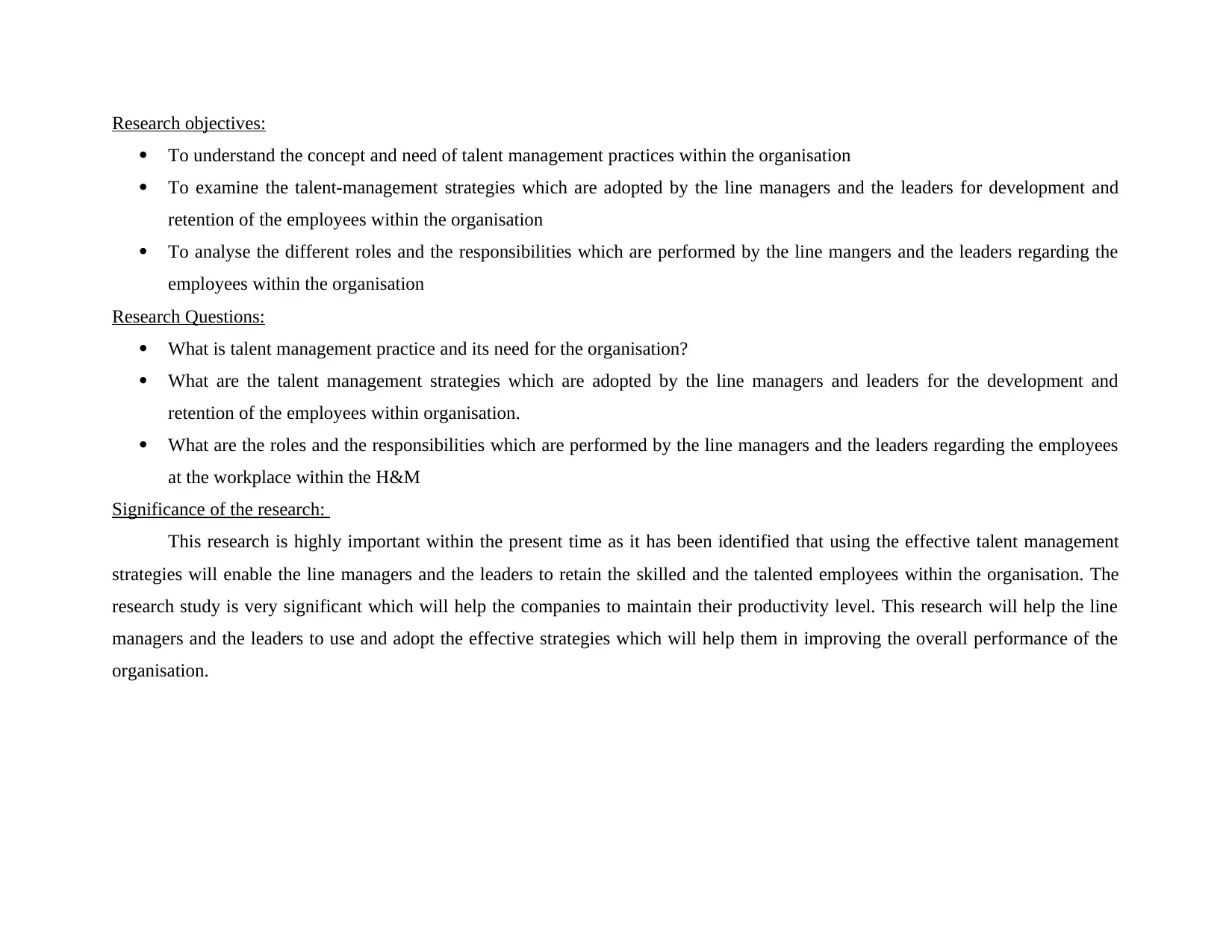
Research objectives:
To understand the concept and need of talent management practices within the organisation
To examine the talent-management strategies which are adopted by the line managers and the leaders for development and
retention of the employees within the organisation
To analyse the different roles and the responsibilities which are performed by the line mangers and the leaders regarding the
employees within the organisation
Research Questions:
What is talent management practice and its need for the organisation?
What are the talent management strategies which are adopted by the line managers and leaders for the development and
retention of the employees within organisation.
What are the roles and the responsibilities which are performed by the line managers and the leaders regarding the employees
at the workplace within the H&M
Significance of the research:
This research is highly important within the present time as it has been identified that using the effective talent management
strategies will enable the line managers and the leaders to retain the skilled and the talented employees within the organisation. The
research study is very significant which will help the companies to maintain their productivity level. This research will help the line
managers and the leaders to use and adopt the effective strategies which will help them in improving the overall performance of the
organisation.
To understand the concept and need of talent management practices within the organisation
To examine the talent-management strategies which are adopted by the line managers and the leaders for development and
retention of the employees within the organisation
To analyse the different roles and the responsibilities which are performed by the line mangers and the leaders regarding the
employees within the organisation
Research Questions:
What is talent management practice and its need for the organisation?
What are the talent management strategies which are adopted by the line managers and leaders for the development and
retention of the employees within organisation.
What are the roles and the responsibilities which are performed by the line managers and the leaders regarding the employees
at the workplace within the H&M
Significance of the research:
This research is highly important within the present time as it has been identified that using the effective talent management
strategies will enable the line managers and the leaders to retain the skilled and the talented employees within the organisation. The
research study is very significant which will help the companies to maintain their productivity level. This research will help the line
managers and the leaders to use and adopt the effective strategies which will help them in improving the overall performance of the
organisation.
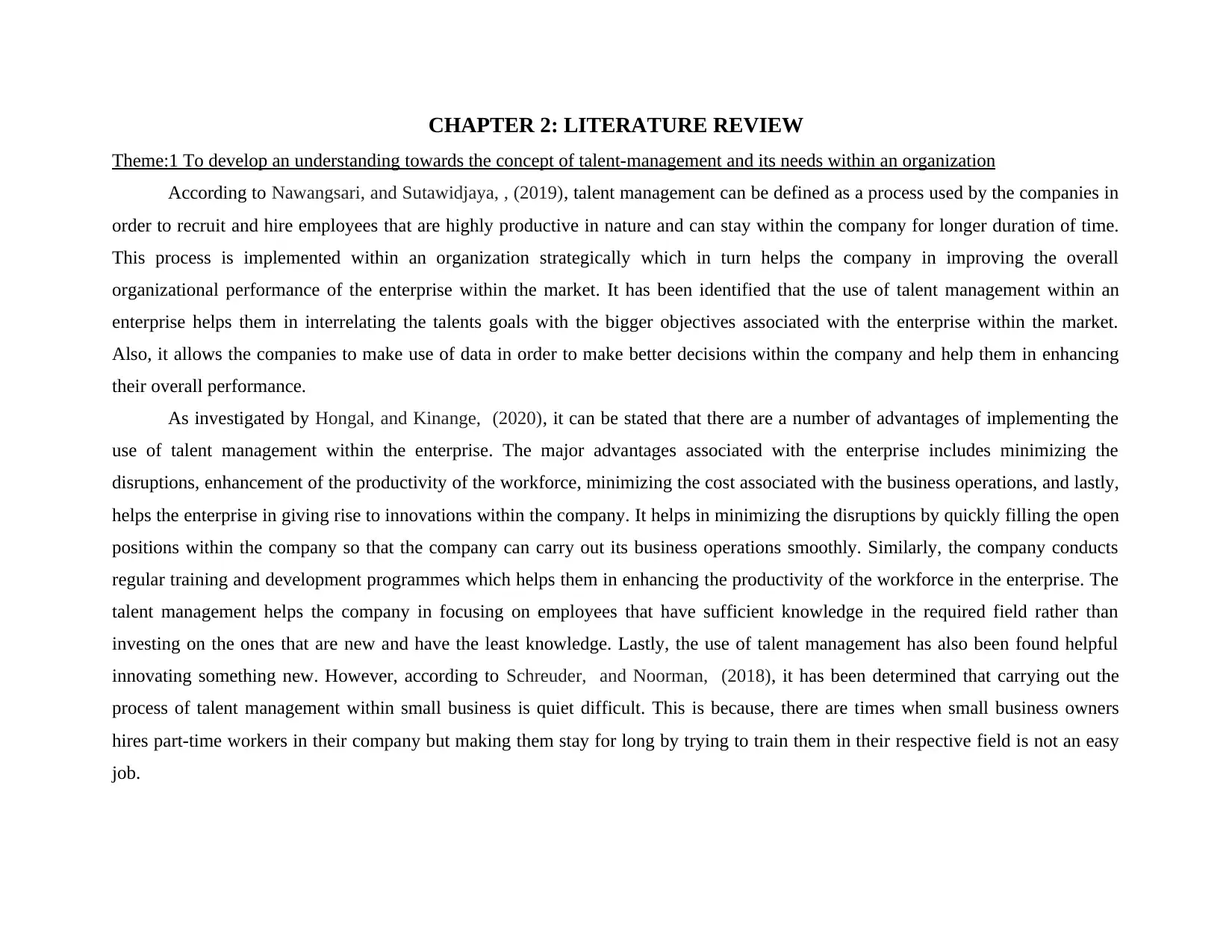
CHAPTER 2: LITERATURE REVIEW
Theme:1 To develop an understanding towards the concept of talent-management and its needs within an organization
According to Nawangsari, and Sutawidjaya, , (2019), talent management can be defined as a process used by the companies in
order to recruit and hire employees that are highly productive in nature and can stay within the company for longer duration of time.
This process is implemented within an organization strategically which in turn helps the company in improving the overall
organizational performance of the enterprise within the market. It has been identified that the use of talent management within an
enterprise helps them in interrelating the talents goals with the bigger objectives associated with the enterprise within the market.
Also, it allows the companies to make use of data in order to make better decisions within the company and help them in enhancing
their overall performance.
As investigated by Hongal, and Kinange, (2020), it can be stated that there are a number of advantages of implementing the
use of talent management within the enterprise. The major advantages associated with the enterprise includes minimizing the
disruptions, enhancement of the productivity of the workforce, minimizing the cost associated with the business operations, and lastly,
helps the enterprise in giving rise to innovations within the company. It helps in minimizing the disruptions by quickly filling the open
positions within the company so that the company can carry out its business operations smoothly. Similarly, the company conducts
regular training and development programmes which helps them in enhancing the productivity of the workforce in the enterprise. The
talent management helps the company in focusing on employees that have sufficient knowledge in the required field rather than
investing on the ones that are new and have the least knowledge. Lastly, the use of talent management has also been found helpful
innovating something new. However, according to Schreuder, and Noorman, (2018), it has been determined that carrying out the
process of talent management within small business is quiet difficult. This is because, there are times when small business owners
hires part-time workers in their company but making them stay for long by trying to train them in their respective field is not an easy
job.
Theme:1 To develop an understanding towards the concept of talent-management and its needs within an organization
According to Nawangsari, and Sutawidjaya, , (2019), talent management can be defined as a process used by the companies in
order to recruit and hire employees that are highly productive in nature and can stay within the company for longer duration of time.
This process is implemented within an organization strategically which in turn helps the company in improving the overall
organizational performance of the enterprise within the market. It has been identified that the use of talent management within an
enterprise helps them in interrelating the talents goals with the bigger objectives associated with the enterprise within the market.
Also, it allows the companies to make use of data in order to make better decisions within the company and help them in enhancing
their overall performance.
As investigated by Hongal, and Kinange, (2020), it can be stated that there are a number of advantages of implementing the
use of talent management within the enterprise. The major advantages associated with the enterprise includes minimizing the
disruptions, enhancement of the productivity of the workforce, minimizing the cost associated with the business operations, and lastly,
helps the enterprise in giving rise to innovations within the company. It helps in minimizing the disruptions by quickly filling the open
positions within the company so that the company can carry out its business operations smoothly. Similarly, the company conducts
regular training and development programmes which helps them in enhancing the productivity of the workforce in the enterprise. The
talent management helps the company in focusing on employees that have sufficient knowledge in the required field rather than
investing on the ones that are new and have the least knowledge. Lastly, the use of talent management has also been found helpful
innovating something new. However, according to Schreuder, and Noorman, (2018), it has been determined that carrying out the
process of talent management within small business is quiet difficult. This is because, there are times when small business owners
hires part-time workers in their company but making them stay for long by trying to train them in their respective field is not an easy
job.
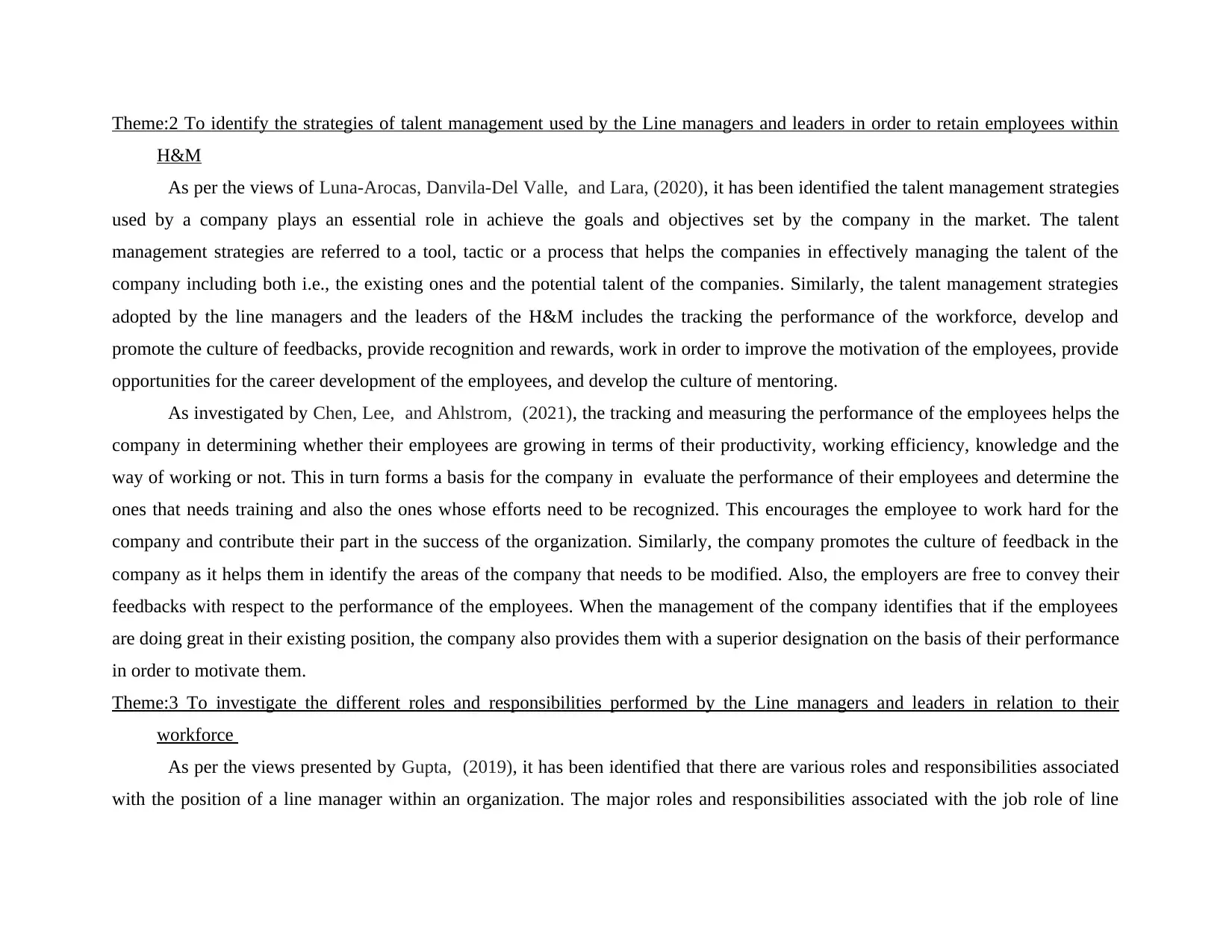
Theme:2 To identify the strategies of talent management used by the Line managers and leaders in order to retain employees within
H&M
As per the views of Luna-Arocas, Danvila-Del Valle, and Lara, (2020), it has been identified the talent management strategies
used by a company plays an essential role in achieve the goals and objectives set by the company in the market. The talent
management strategies are referred to a tool, tactic or a process that helps the companies in effectively managing the talent of the
company including both i.e., the existing ones and the potential talent of the companies. Similarly, the talent management strategies
adopted by the line managers and the leaders of the H&M includes the tracking the performance of the workforce, develop and
promote the culture of feedbacks, provide recognition and rewards, work in order to improve the motivation of the employees, provide
opportunities for the career development of the employees, and develop the culture of mentoring.
As investigated by Chen, Lee, and Ahlstrom, (2021), the tracking and measuring the performance of the employees helps the
company in determining whether their employees are growing in terms of their productivity, working efficiency, knowledge and the
way of working or not. This in turn forms a basis for the company in evaluate the performance of their employees and determine the
ones that needs training and also the ones whose efforts need to be recognized. This encourages the employee to work hard for the
company and contribute their part in the success of the organization. Similarly, the company promotes the culture of feedback in the
company as it helps them in identify the areas of the company that needs to be modified. Also, the employers are free to convey their
feedbacks with respect to the performance of the employees. When the management of the company identifies that if the employees
are doing great in their existing position, the company also provides them with a superior designation on the basis of their performance
in order to motivate them.
Theme:3 To investigate the different roles and responsibilities performed by the Line managers and leaders in relation to their
workforce
As per the views presented by Gupta, (2019), it has been identified that there are various roles and responsibilities associated
with the position of a line manager within an organization. The major roles and responsibilities associated with the job role of line
H&M
As per the views of Luna-Arocas, Danvila-Del Valle, and Lara, (2020), it has been identified the talent management strategies
used by a company plays an essential role in achieve the goals and objectives set by the company in the market. The talent
management strategies are referred to a tool, tactic or a process that helps the companies in effectively managing the talent of the
company including both i.e., the existing ones and the potential talent of the companies. Similarly, the talent management strategies
adopted by the line managers and the leaders of the H&M includes the tracking the performance of the workforce, develop and
promote the culture of feedbacks, provide recognition and rewards, work in order to improve the motivation of the employees, provide
opportunities for the career development of the employees, and develop the culture of mentoring.
As investigated by Chen, Lee, and Ahlstrom, (2021), the tracking and measuring the performance of the employees helps the
company in determining whether their employees are growing in terms of their productivity, working efficiency, knowledge and the
way of working or not. This in turn forms a basis for the company in evaluate the performance of their employees and determine the
ones that needs training and also the ones whose efforts need to be recognized. This encourages the employee to work hard for the
company and contribute their part in the success of the organization. Similarly, the company promotes the culture of feedback in the
company as it helps them in identify the areas of the company that needs to be modified. Also, the employers are free to convey their
feedbacks with respect to the performance of the employees. When the management of the company identifies that if the employees
are doing great in their existing position, the company also provides them with a superior designation on the basis of their performance
in order to motivate them.
Theme:3 To investigate the different roles and responsibilities performed by the Line managers and leaders in relation to their
workforce
As per the views presented by Gupta, (2019), it has been identified that there are various roles and responsibilities associated
with the position of a line manager within an organization. The major roles and responsibilities associated with the job role of line
Paraphrase This Document
Need a fresh take? Get an instant paraphrase of this document with our AI Paraphraser
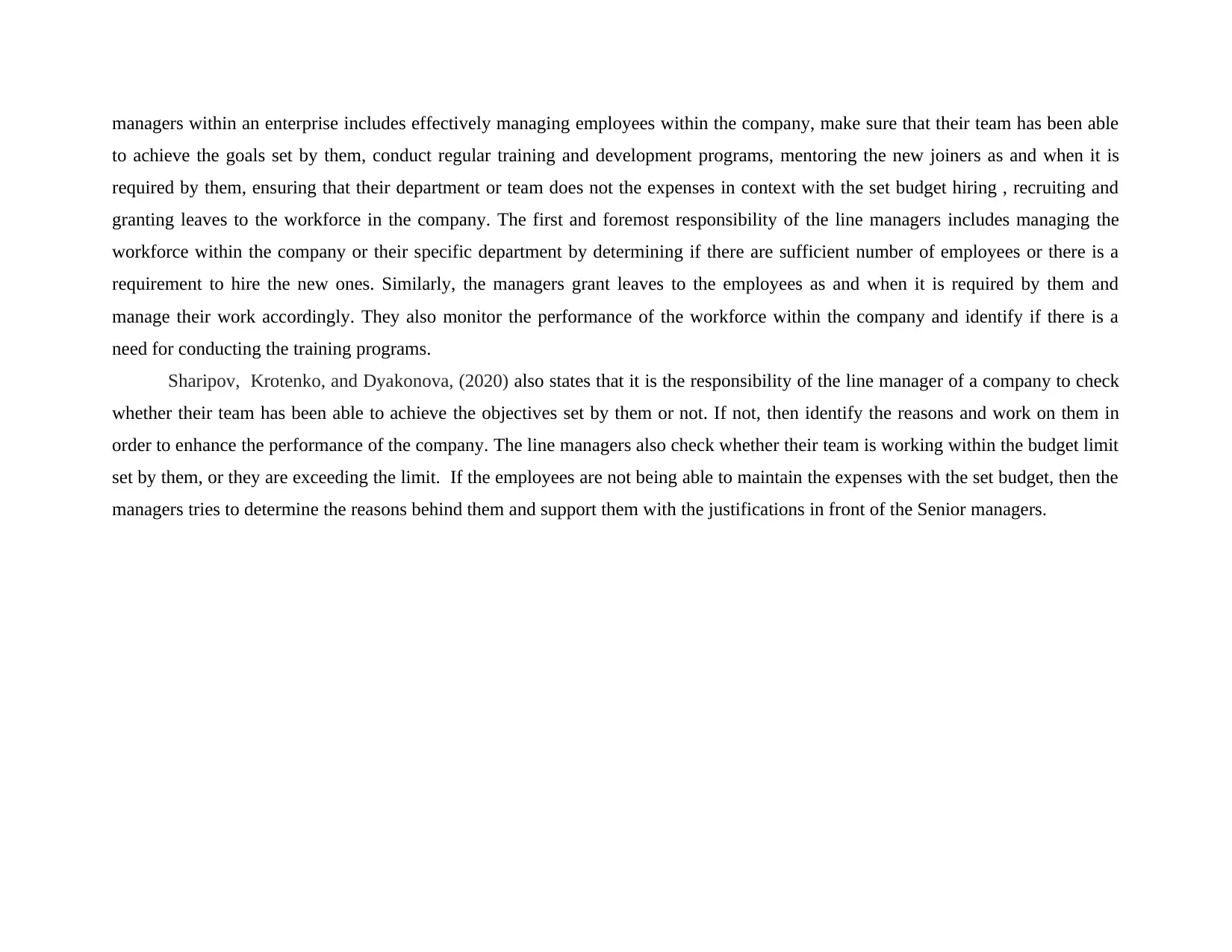
managers within an enterprise includes effectively managing employees within the company, make sure that their team has been able
to achieve the goals set by them, conduct regular training and development programs, mentoring the new joiners as and when it is
required by them, ensuring that their department or team does not the expenses in context with the set budget hiring , recruiting and
granting leaves to the workforce in the company. The first and foremost responsibility of the line managers includes managing the
workforce within the company or their specific department by determining if there are sufficient number of employees or there is a
requirement to hire the new ones. Similarly, the managers grant leaves to the employees as and when it is required by them and
manage their work accordingly. They also monitor the performance of the workforce within the company and identify if there is a
need for conducting the training programs.
Sharipov, Krotenko, and Dyakonova, (2020) also states that it is the responsibility of the line manager of a company to check
whether their team has been able to achieve the objectives set by them or not. If not, then identify the reasons and work on them in
order to enhance the performance of the company. The line managers also check whether their team is working within the budget limit
set by them, or they are exceeding the limit. If the employees are not being able to maintain the expenses with the set budget, then the
managers tries to determine the reasons behind them and support them with the justifications in front of the Senior managers.
to achieve the goals set by them, conduct regular training and development programs, mentoring the new joiners as and when it is
required by them, ensuring that their department or team does not the expenses in context with the set budget hiring , recruiting and
granting leaves to the workforce in the company. The first and foremost responsibility of the line managers includes managing the
workforce within the company or their specific department by determining if there are sufficient number of employees or there is a
requirement to hire the new ones. Similarly, the managers grant leaves to the employees as and when it is required by them and
manage their work accordingly. They also monitor the performance of the workforce within the company and identify if there is a
need for conducting the training programs.
Sharipov, Krotenko, and Dyakonova, (2020) also states that it is the responsibility of the line manager of a company to check
whether their team has been able to achieve the objectives set by them or not. If not, then identify the reasons and work on them in
order to enhance the performance of the company. The line managers also check whether their team is working within the budget limit
set by them, or they are exceeding the limit. If the employees are not being able to maintain the expenses with the set budget, then the
managers tries to determine the reasons behind them and support them with the justifications in front of the Senior managers.
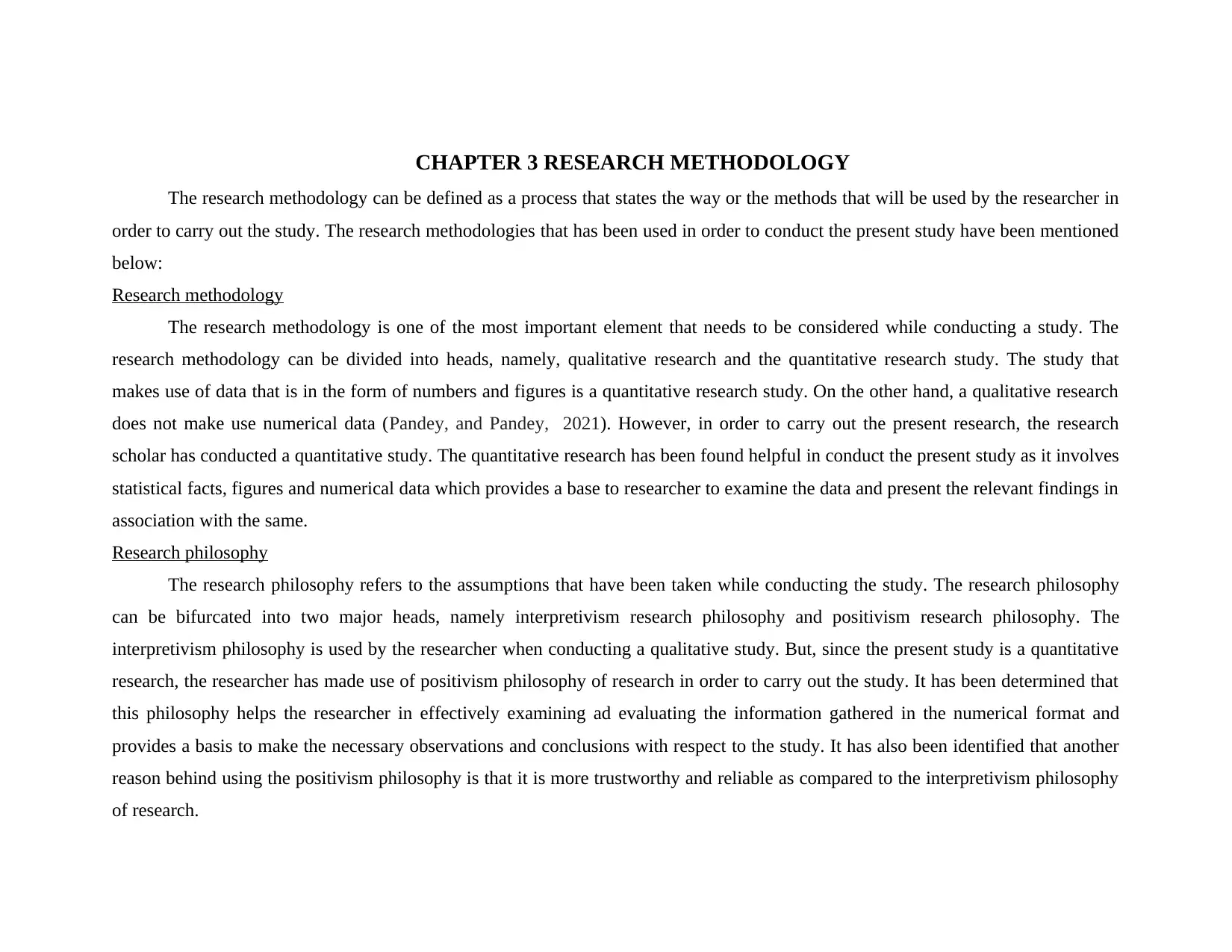
CHAPTER 3 RESEARCH METHODOLOGY
The research methodology can be defined as a process that states the way or the methods that will be used by the researcher in
order to carry out the study. The research methodologies that has been used in order to conduct the present study have been mentioned
below:
Research methodology
The research methodology is one of the most important element that needs to be considered while conducting a study. The
research methodology can be divided into heads, namely, qualitative research and the quantitative research study. The study that
makes use of data that is in the form of numbers and figures is a quantitative research study. On the other hand, a qualitative research
does not make use numerical data (Pandey, and Pandey, 2021). However, in order to carry out the present research, the research
scholar has conducted a quantitative study. The quantitative research has been found helpful in conduct the present study as it involves
statistical facts, figures and numerical data which provides a base to researcher to examine the data and present the relevant findings in
association with the same.
Research philosophy
The research philosophy refers to the assumptions that have been taken while conducting the study. The research philosophy
can be bifurcated into two major heads, namely interpretivism research philosophy and positivism research philosophy. The
interpretivism philosophy is used by the researcher when conducting a qualitative study. But, since the present study is a quantitative
research, the researcher has made use of positivism philosophy of research in order to carry out the study. It has been determined that
this philosophy helps the researcher in effectively examining ad evaluating the information gathered in the numerical format and
provides a basis to make the necessary observations and conclusions with respect to the study. It has also been identified that another
reason behind using the positivism philosophy is that it is more trustworthy and reliable as compared to the interpretivism philosophy
of research.
The research methodology can be defined as a process that states the way or the methods that will be used by the researcher in
order to carry out the study. The research methodologies that has been used in order to conduct the present study have been mentioned
below:
Research methodology
The research methodology is one of the most important element that needs to be considered while conducting a study. The
research methodology can be divided into heads, namely, qualitative research and the quantitative research study. The study that
makes use of data that is in the form of numbers and figures is a quantitative research study. On the other hand, a qualitative research
does not make use numerical data (Pandey, and Pandey, 2021). However, in order to carry out the present research, the research
scholar has conducted a quantitative study. The quantitative research has been found helpful in conduct the present study as it involves
statistical facts, figures and numerical data which provides a base to researcher to examine the data and present the relevant findings in
association with the same.
Research philosophy
The research philosophy refers to the assumptions that have been taken while conducting the study. The research philosophy
can be bifurcated into two major heads, namely interpretivism research philosophy and positivism research philosophy. The
interpretivism philosophy is used by the researcher when conducting a qualitative study. But, since the present study is a quantitative
research, the researcher has made use of positivism philosophy of research in order to carry out the study. It has been determined that
this philosophy helps the researcher in effectively examining ad evaluating the information gathered in the numerical format and
provides a basis to make the necessary observations and conclusions with respect to the study. It has also been identified that another
reason behind using the positivism philosophy is that it is more trustworthy and reliable as compared to the interpretivism philosophy
of research.
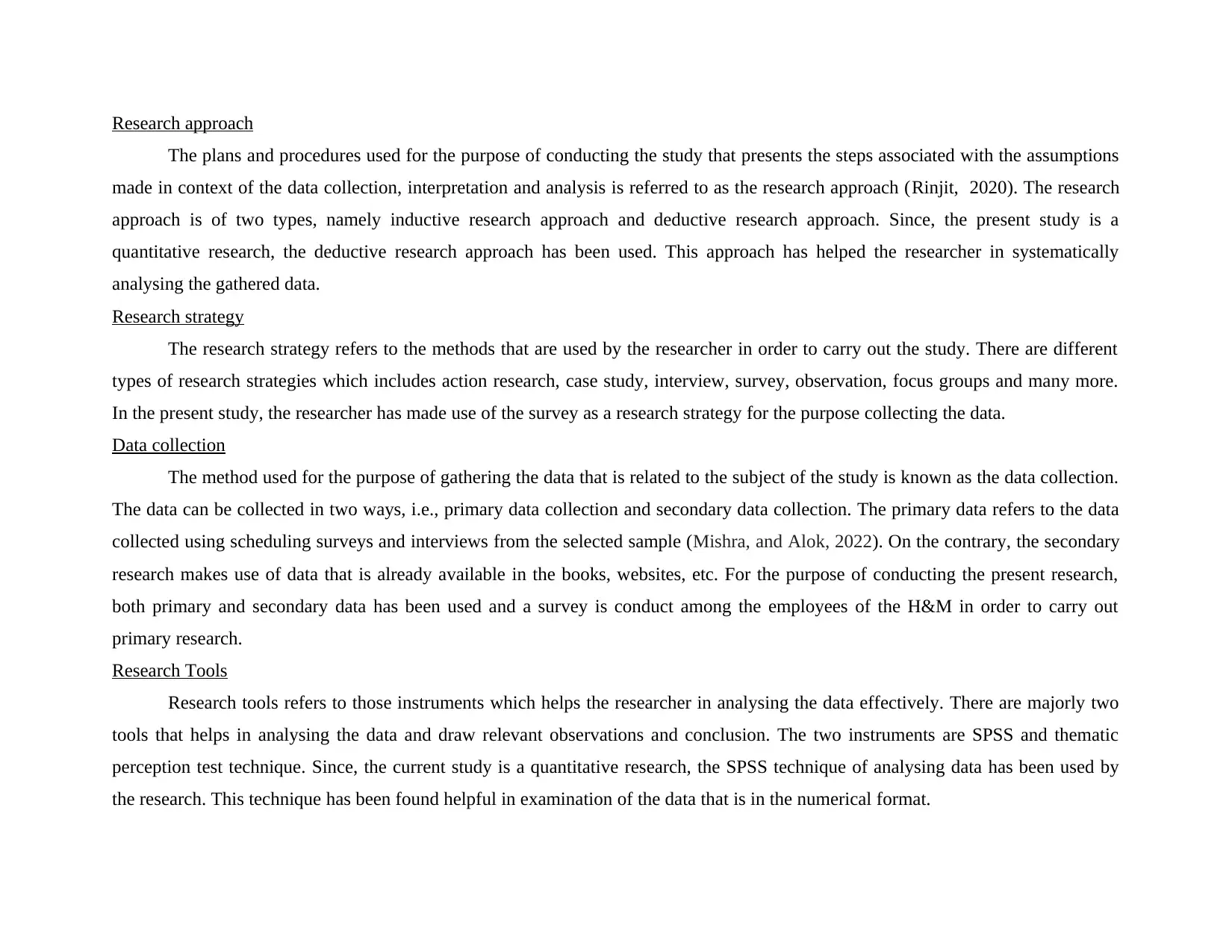
Research approach
The plans and procedures used for the purpose of conducting the study that presents the steps associated with the assumptions
made in context of the data collection, interpretation and analysis is referred to as the research approach (Rinjit, 2020). The research
approach is of two types, namely inductive research approach and deductive research approach. Since, the present study is a
quantitative research, the deductive research approach has been used. This approach has helped the researcher in systematically
analysing the gathered data.
Research strategy
The research strategy refers to the methods that are used by the researcher in order to carry out the study. There are different
types of research strategies which includes action research, case study, interview, survey, observation, focus groups and many more.
In the present study, the researcher has made use of the survey as a research strategy for the purpose collecting the data.
Data collection
The method used for the purpose of gathering the data that is related to the subject of the study is known as the data collection.
The data can be collected in two ways, i.e., primary data collection and secondary data collection. The primary data refers to the data
collected using scheduling surveys and interviews from the selected sample (Mishra, and Alok, 2022). On the contrary, the secondary
research makes use of data that is already available in the books, websites, etc. For the purpose of conducting the present research,
both primary and secondary data has been used and a survey is conduct among the employees of the H&M in order to carry out
primary research.
Research Tools
Research tools refers to those instruments which helps the researcher in analysing the data effectively. There are majorly two
tools that helps in analysing the data and draw relevant observations and conclusion. The two instruments are SPSS and thematic
perception test technique. Since, the current study is a quantitative research, the SPSS technique of analysing data has been used by
the research. This technique has been found helpful in examination of the data that is in the numerical format.
The plans and procedures used for the purpose of conducting the study that presents the steps associated with the assumptions
made in context of the data collection, interpretation and analysis is referred to as the research approach (Rinjit, 2020). The research
approach is of two types, namely inductive research approach and deductive research approach. Since, the present study is a
quantitative research, the deductive research approach has been used. This approach has helped the researcher in systematically
analysing the gathered data.
Research strategy
The research strategy refers to the methods that are used by the researcher in order to carry out the study. There are different
types of research strategies which includes action research, case study, interview, survey, observation, focus groups and many more.
In the present study, the researcher has made use of the survey as a research strategy for the purpose collecting the data.
Data collection
The method used for the purpose of gathering the data that is related to the subject of the study is known as the data collection.
The data can be collected in two ways, i.e., primary data collection and secondary data collection. The primary data refers to the data
collected using scheduling surveys and interviews from the selected sample (Mishra, and Alok, 2022). On the contrary, the secondary
research makes use of data that is already available in the books, websites, etc. For the purpose of conducting the present research,
both primary and secondary data has been used and a survey is conduct among the employees of the H&M in order to carry out
primary research.
Research Tools
Research tools refers to those instruments which helps the researcher in analysing the data effectively. There are majorly two
tools that helps in analysing the data and draw relevant observations and conclusion. The two instruments are SPSS and thematic
perception test technique. Since, the current study is a quantitative research, the SPSS technique of analysing data has been used by
the research. This technique has been found helpful in examination of the data that is in the numerical format.
Secure Best Marks with AI Grader
Need help grading? Try our AI Grader for instant feedback on your assignments.
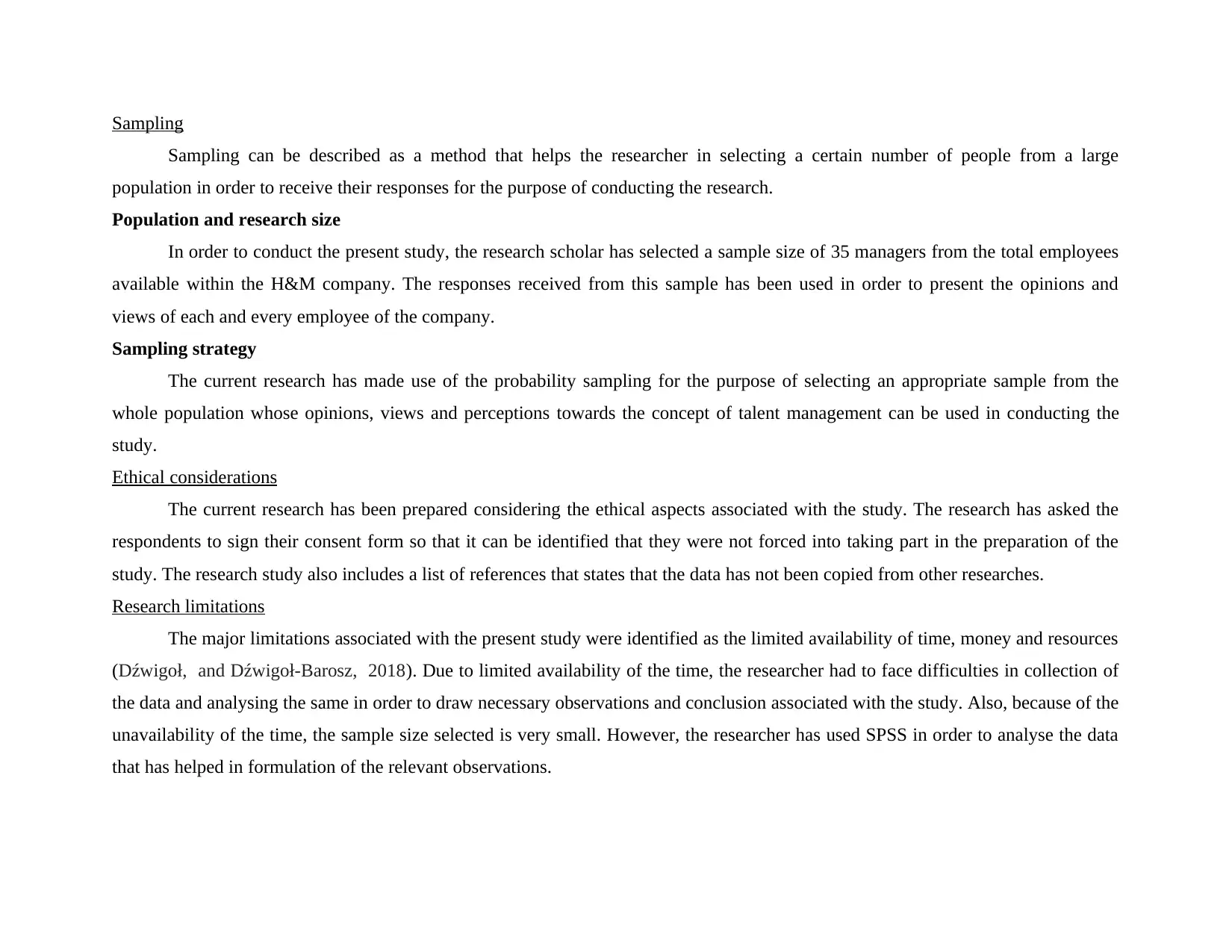
Sampling
Sampling can be described as a method that helps the researcher in selecting a certain number of people from a large
population in order to receive their responses for the purpose of conducting the research.
Population and research size
In order to conduct the present study, the research scholar has selected a sample size of 35 managers from the total employees
available within the H&M company. The responses received from this sample has been used in order to present the opinions and
views of each and every employee of the company.
Sampling strategy
The current research has made use of the probability sampling for the purpose of selecting an appropriate sample from the
whole population whose opinions, views and perceptions towards the concept of talent management can be used in conducting the
study.
Ethical considerations
The current research has been prepared considering the ethical aspects associated with the study. The research has asked the
respondents to sign their consent form so that it can be identified that they were not forced into taking part in the preparation of the
study. The research study also includes a list of references that states that the data has not been copied from other researches.
Research limitations
The major limitations associated with the present study were identified as the limited availability of time, money and resources
(Dźwigoł, and Dźwigoł-Barosz, 2018). Due to limited availability of the time, the researcher had to face difficulties in collection of
the data and analysing the same in order to draw necessary observations and conclusion associated with the study. Also, because of the
unavailability of the time, the sample size selected is very small. However, the researcher has used SPSS in order to analyse the data
that has helped in formulation of the relevant observations.
Sampling can be described as a method that helps the researcher in selecting a certain number of people from a large
population in order to receive their responses for the purpose of conducting the research.
Population and research size
In order to conduct the present study, the research scholar has selected a sample size of 35 managers from the total employees
available within the H&M company. The responses received from this sample has been used in order to present the opinions and
views of each and every employee of the company.
Sampling strategy
The current research has made use of the probability sampling for the purpose of selecting an appropriate sample from the
whole population whose opinions, views and perceptions towards the concept of talent management can be used in conducting the
study.
Ethical considerations
The current research has been prepared considering the ethical aspects associated with the study. The research has asked the
respondents to sign their consent form so that it can be identified that they were not forced into taking part in the preparation of the
study. The research study also includes a list of references that states that the data has not been copied from other researches.
Research limitations
The major limitations associated with the present study were identified as the limited availability of time, money and resources
(Dźwigoł, and Dźwigoł-Barosz, 2018). Due to limited availability of the time, the researcher had to face difficulties in collection of
the data and analysing the same in order to draw necessary observations and conclusion associated with the study. Also, because of the
unavailability of the time, the sample size selected is very small. However, the researcher has used SPSS in order to analyse the data
that has helped in formulation of the relevant observations.
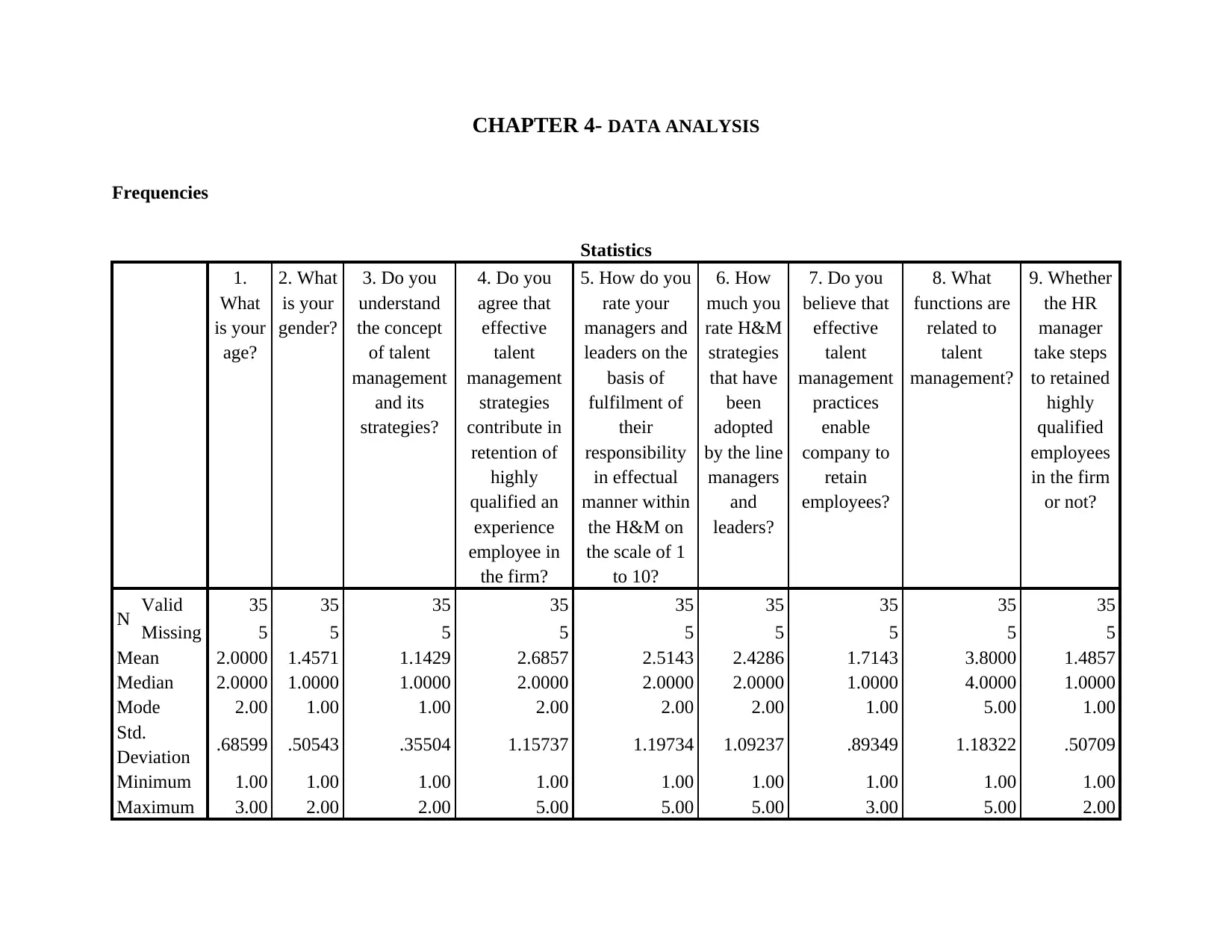
CHAPTER 4- DATA ANALYSIS
Frequencies
Statistics
1.
What
is your
age?
2. What
is your
gender?
3. Do you
understand
the concept
of talent
management
and its
strategies?
4. Do you
agree that
effective
talent
management
strategies
contribute in
retention of
highly
qualified an
experience
employee in
the firm?
5. How do you
rate your
managers and
leaders on the
basis of
fulfilment of
their
responsibility
in effectual
manner within
the H&M on
the scale of 1
to 10?
6. How
much you
rate H&M
strategies
that have
been
adopted
by the line
managers
and
leaders?
7. Do you
believe that
effective
talent
management
practices
enable
company to
retain
employees?
8. What
functions are
related to
talent
management?
9. Whether
the HR
manager
take steps
to retained
highly
qualified
employees
in the firm
or not?
N Valid 35 35 35 35 35 35 35 35 35
Missing 5 5 5 5 5 5 5 5 5
Mean 2.0000 1.4571 1.1429 2.6857 2.5143 2.4286 1.7143 3.8000 1.4857
Median 2.0000 1.0000 1.0000 2.0000 2.0000 2.0000 1.0000 4.0000 1.0000
Mode 2.00 1.00 1.00 2.00 2.00 2.00 1.00 5.00 1.00
Std.
Deviation .68599 .50543 .35504 1.15737 1.19734 1.09237 .89349 1.18322 .50709
Minimum 1.00 1.00 1.00 1.00 1.00 1.00 1.00 1.00 1.00
Maximum 3.00 2.00 2.00 5.00 5.00 5.00 3.00 5.00 2.00
Frequencies
Statistics
1.
What
is your
age?
2. What
is your
gender?
3. Do you
understand
the concept
of talent
management
and its
strategies?
4. Do you
agree that
effective
talent
management
strategies
contribute in
retention of
highly
qualified an
experience
employee in
the firm?
5. How do you
rate your
managers and
leaders on the
basis of
fulfilment of
their
responsibility
in effectual
manner within
the H&M on
the scale of 1
to 10?
6. How
much you
rate H&M
strategies
that have
been
adopted
by the line
managers
and
leaders?
7. Do you
believe that
effective
talent
management
practices
enable
company to
retain
employees?
8. What
functions are
related to
talent
management?
9. Whether
the HR
manager
take steps
to retained
highly
qualified
employees
in the firm
or not?
N Valid 35 35 35 35 35 35 35 35 35
Missing 5 5 5 5 5 5 5 5 5
Mean 2.0000 1.4571 1.1429 2.6857 2.5143 2.4286 1.7143 3.8000 1.4857
Median 2.0000 1.0000 1.0000 2.0000 2.0000 2.0000 1.0000 4.0000 1.0000
Mode 2.00 1.00 1.00 2.00 2.00 2.00 1.00 5.00 1.00
Std.
Deviation .68599 .50543 .35504 1.15737 1.19734 1.09237 .89349 1.18322 .50709
Minimum 1.00 1.00 1.00 1.00 1.00 1.00 1.00 1.00 1.00
Maximum 3.00 2.00 2.00 5.00 5.00 5.00 3.00 5.00 2.00
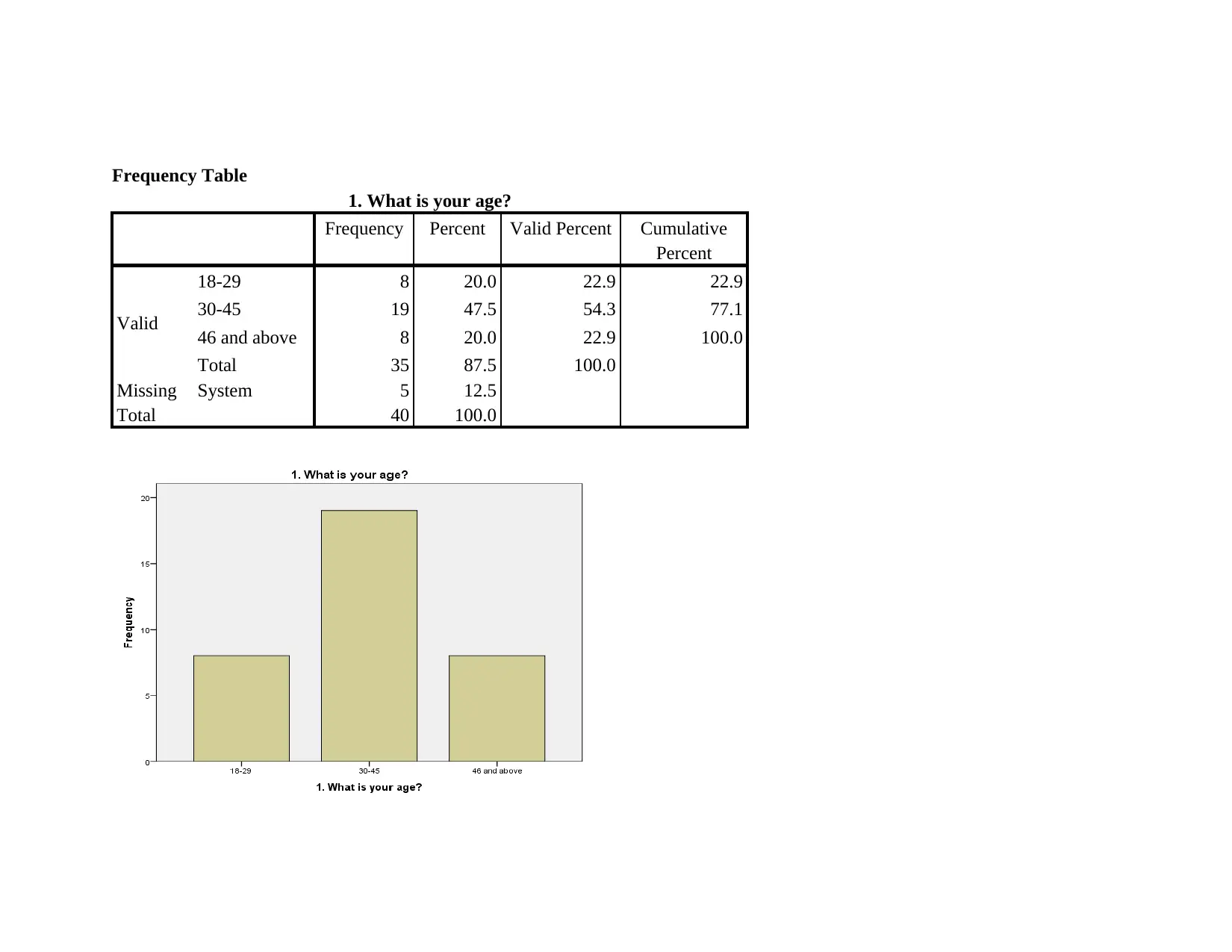
Frequency Table
1. What is your age?
Frequency Percent Valid Percent Cumulative
Percent
Valid
18-29 8 20.0 22.9 22.9
30-45 19 47.5 54.3 77.1
46 and above 8 20.0 22.9 100.0
Total 35 87.5 100.0
Missing System 5 12.5
Total 40 100.0
1. What is your age?
Frequency Percent Valid Percent Cumulative
Percent
Valid
18-29 8 20.0 22.9 22.9
30-45 19 47.5 54.3 77.1
46 and above 8 20.0 22.9 100.0
Total 35 87.5 100.0
Missing System 5 12.5
Total 40 100.0
Paraphrase This Document
Need a fresh take? Get an instant paraphrase of this document with our AI Paraphraser
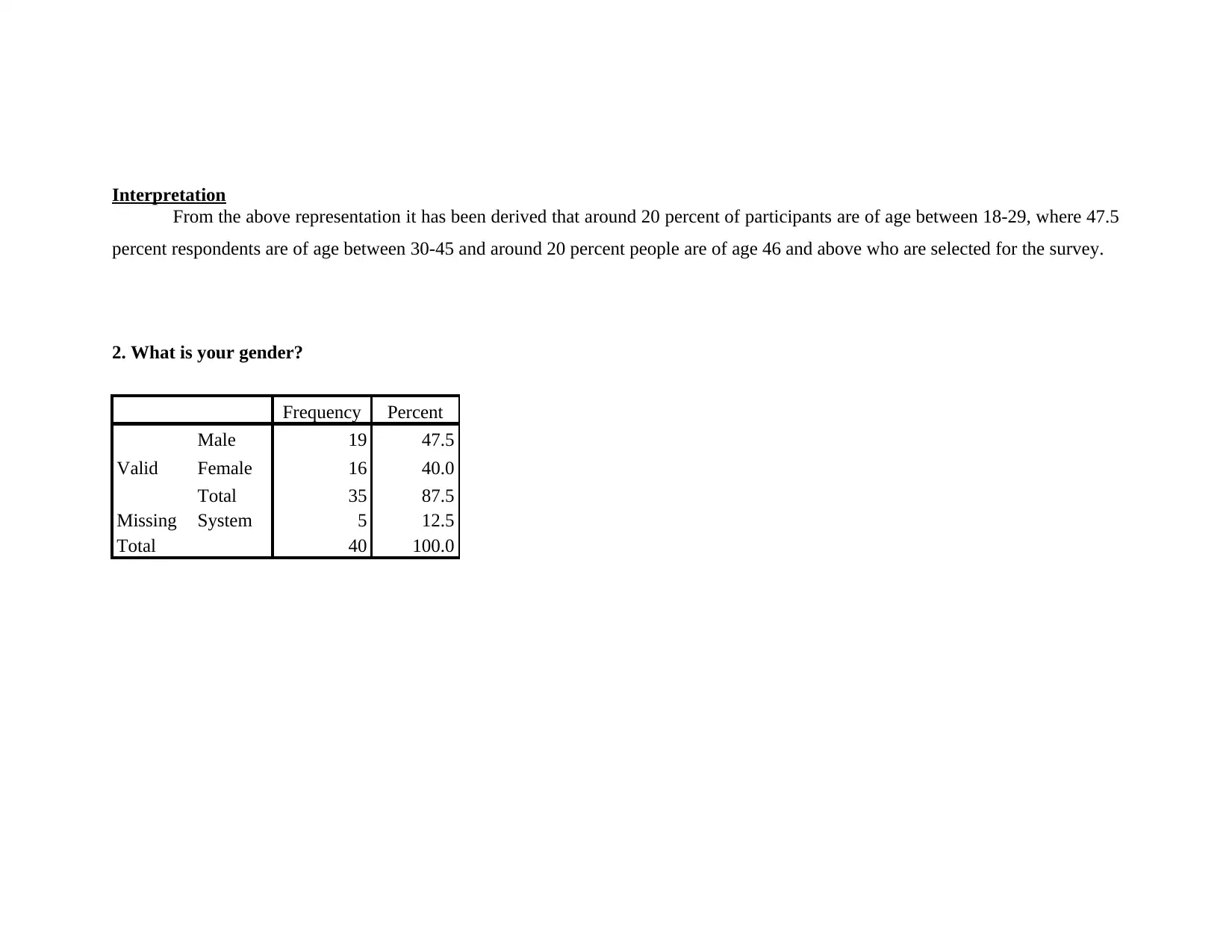
Interpretation
From the above representation it has been derived that around 20 percent of participants are of age between 18-29, where 47.5
percent respondents are of age between 30-45 and around 20 percent people are of age 46 and above who are selected for the survey.
2. What is your gender?
Frequency Percent
Valid
Male 19 47.5
Female 16 40.0
Total 35 87.5
Missing System 5 12.5
Total 40 100.0
From the above representation it has been derived that around 20 percent of participants are of age between 18-29, where 47.5
percent respondents are of age between 30-45 and around 20 percent people are of age 46 and above who are selected for the survey.
2. What is your gender?
Frequency Percent
Valid
Male 19 47.5
Female 16 40.0
Total 35 87.5
Missing System 5 12.5
Total 40 100.0
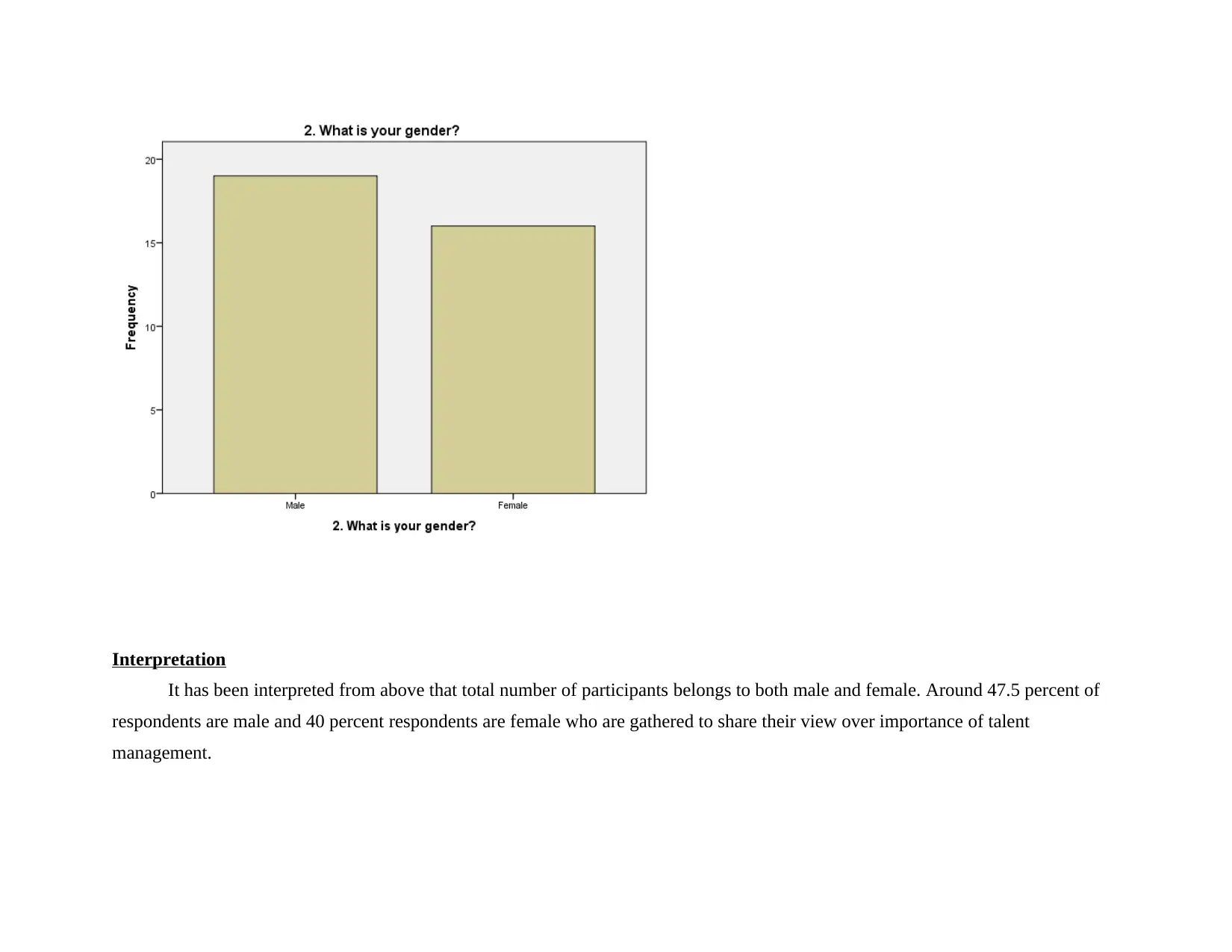
Interpretation
It has been interpreted from above that total number of participants belongs to both male and female. Around 47.5 percent of
respondents are male and 40 percent respondents are female who are gathered to share their view over importance of talent
management.
It has been interpreted from above that total number of participants belongs to both male and female. Around 47.5 percent of
respondents are male and 40 percent respondents are female who are gathered to share their view over importance of talent
management.
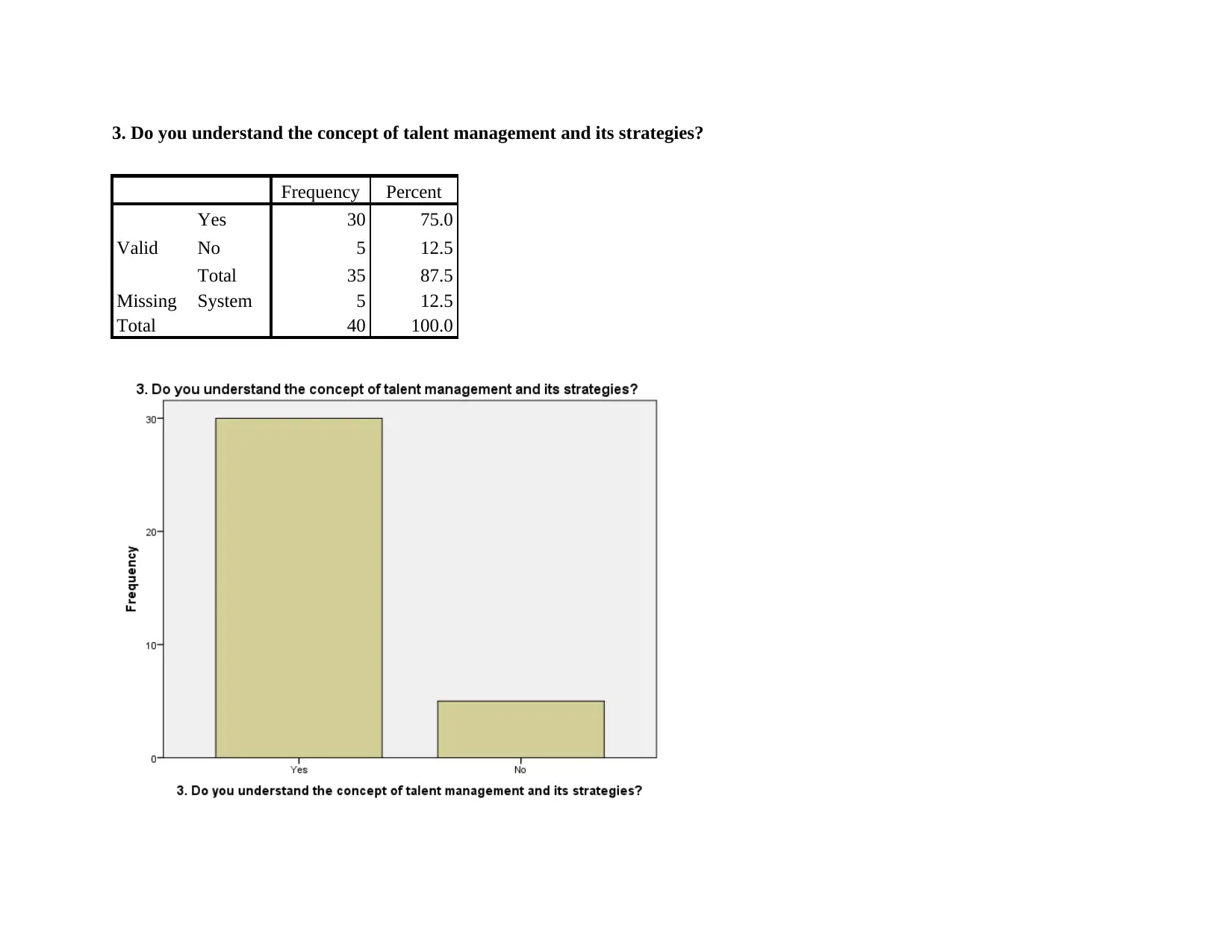
3. Do you understand the concept of talent management and its strategies?
Frequency Percent
Valid
Yes 30 75.0
No 5 12.5
Total 35 87.5
Missing System 5 12.5
Total 40 100.0
Frequency Percent
Valid
Yes 30 75.0
No 5 12.5
Total 35 87.5
Missing System 5 12.5
Total 40 100.0
Secure Best Marks with AI Grader
Need help grading? Try our AI Grader for instant feedback on your assignments.
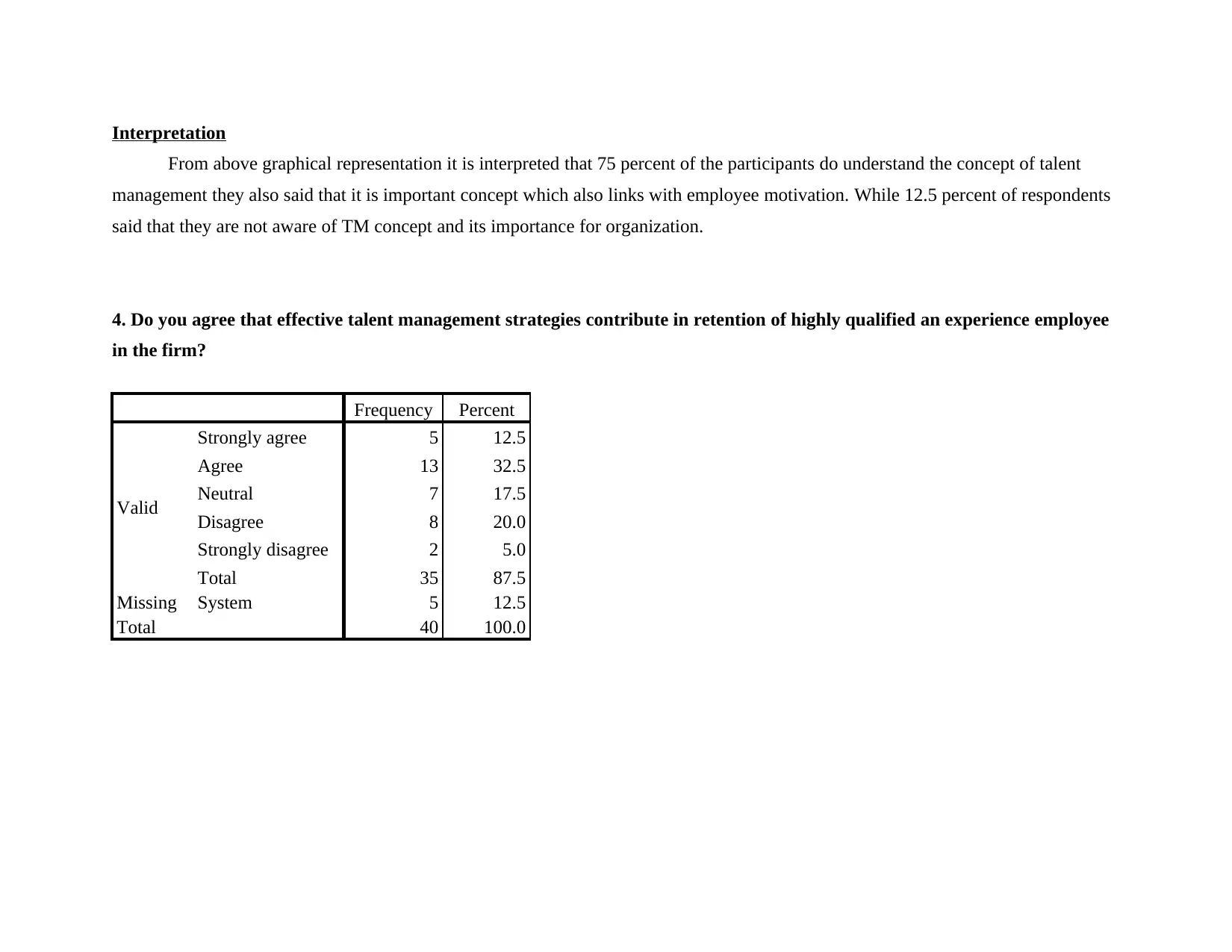
Interpretation
From above graphical representation it is interpreted that 75 percent of the participants do understand the concept of talent
management they also said that it is important concept which also links with employee motivation. While 12.5 percent of respondents
said that they are not aware of TM concept and its importance for organization.
4. Do you agree that effective talent management strategies contribute in retention of highly qualified an experience employee
in the firm?
Frequency Percent
Valid
Strongly agree 5 12.5
Agree 13 32.5
Neutral 7 17.5
Disagree 8 20.0
Strongly disagree 2 5.0
Total 35 87.5
Missing System 5 12.5
Total 40 100.0
From above graphical representation it is interpreted that 75 percent of the participants do understand the concept of talent
management they also said that it is important concept which also links with employee motivation. While 12.5 percent of respondents
said that they are not aware of TM concept and its importance for organization.
4. Do you agree that effective talent management strategies contribute in retention of highly qualified an experience employee
in the firm?
Frequency Percent
Valid
Strongly agree 5 12.5
Agree 13 32.5
Neutral 7 17.5
Disagree 8 20.0
Strongly disagree 2 5.0
Total 35 87.5
Missing System 5 12.5
Total 40 100.0
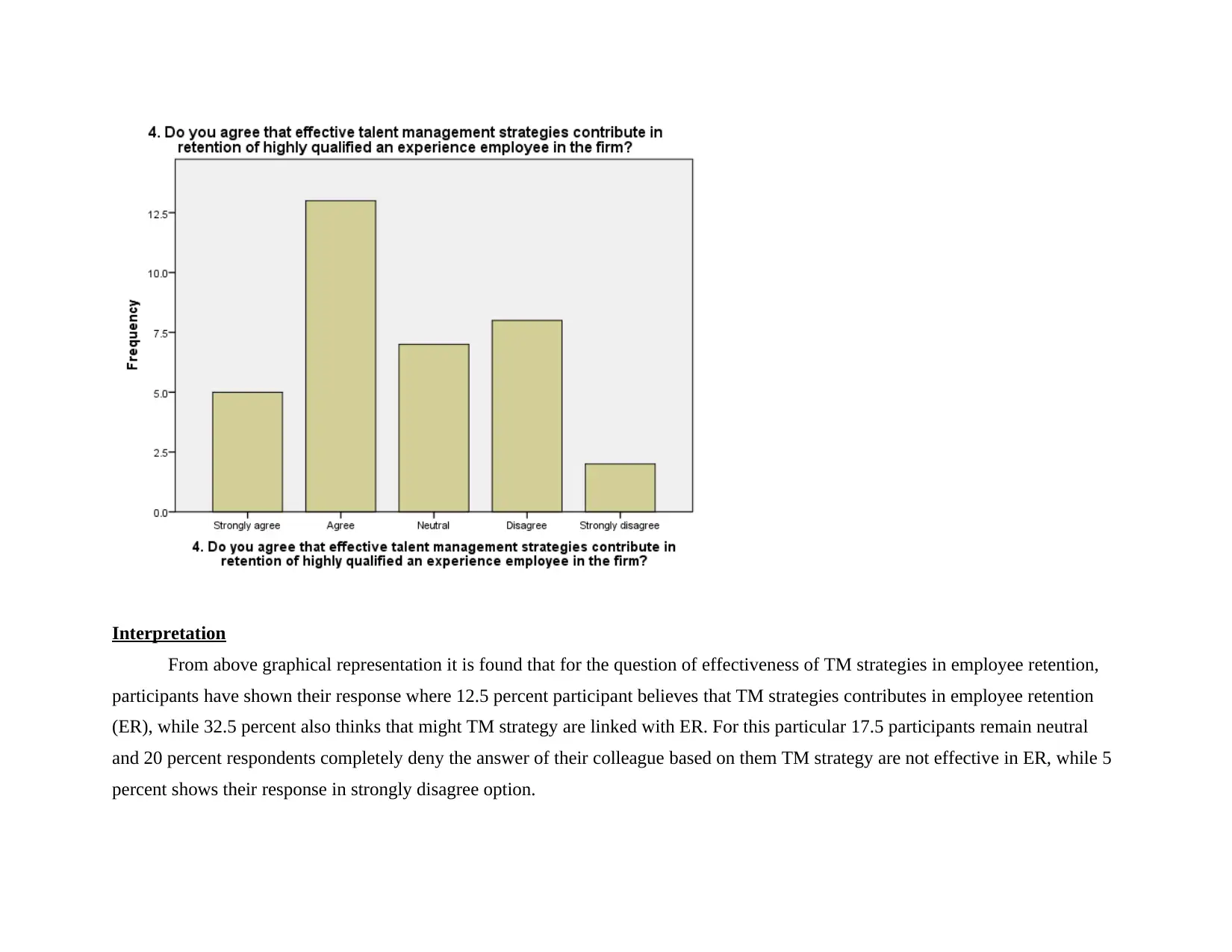
Interpretation
From above graphical representation it is found that for the question of effectiveness of TM strategies in employee retention,
participants have shown their response where 12.5 percent participant believes that TM strategies contributes in employee retention
(ER), while 32.5 percent also thinks that might TM strategy are linked with ER. For this particular 17.5 participants remain neutral
and 20 percent respondents completely deny the answer of their colleague based on them TM strategy are not effective in ER, while 5
percent shows their response in strongly disagree option.
From above graphical representation it is found that for the question of effectiveness of TM strategies in employee retention,
participants have shown their response where 12.5 percent participant believes that TM strategies contributes in employee retention
(ER), while 32.5 percent also thinks that might TM strategy are linked with ER. For this particular 17.5 participants remain neutral
and 20 percent respondents completely deny the answer of their colleague based on them TM strategy are not effective in ER, while 5
percent shows their response in strongly disagree option.
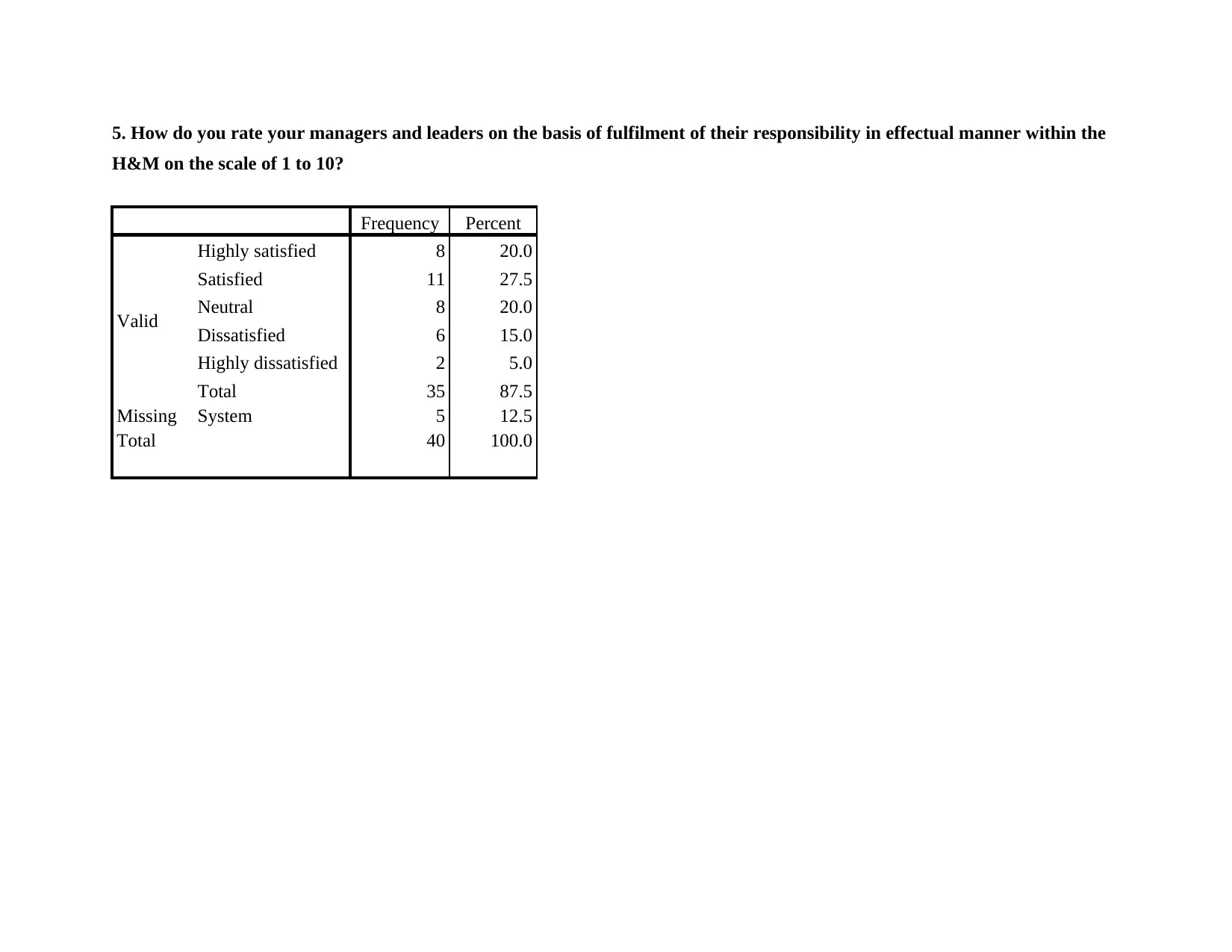
5. How do you rate your managers and leaders on the basis of fulfilment of their responsibility in effectual manner within the
H&M on the scale of 1 to 10?
Frequency Percent
Valid
Highly satisfied 8 20.0
Satisfied 11 27.5
Neutral 8 20.0
Dissatisfied 6 15.0
Highly dissatisfied 2 5.0
Total 35 87.5
Missing System 5 12.5
Total 40 100.0
H&M on the scale of 1 to 10?
Frequency Percent
Valid
Highly satisfied 8 20.0
Satisfied 11 27.5
Neutral 8 20.0
Dissatisfied 6 15.0
Highly dissatisfied 2 5.0
Total 35 87.5
Missing System 5 12.5
Total 40 100.0
Paraphrase This Document
Need a fresh take? Get an instant paraphrase of this document with our AI Paraphraser
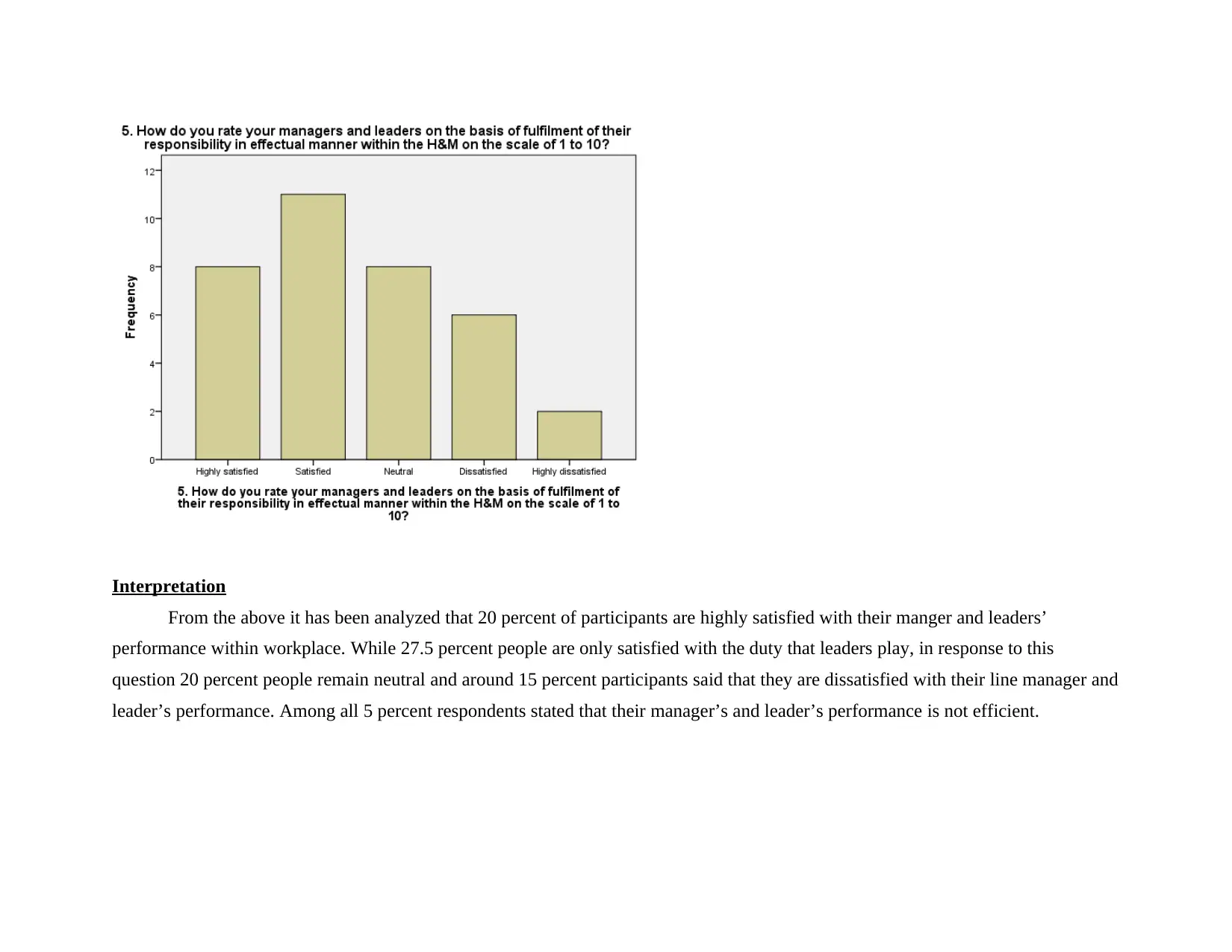
Interpretation
From the above it has been analyzed that 20 percent of participants are highly satisfied with their manger and leaders’
performance within workplace. While 27.5 percent people are only satisfied with the duty that leaders play, in response to this
question 20 percent people remain neutral and around 15 percent participants said that they are dissatisfied with their line manager and
leader’s performance. Among all 5 percent respondents stated that their manager’s and leader’s performance is not efficient.
From the above it has been analyzed that 20 percent of participants are highly satisfied with their manger and leaders’
performance within workplace. While 27.5 percent people are only satisfied with the duty that leaders play, in response to this
question 20 percent people remain neutral and around 15 percent participants said that they are dissatisfied with their line manager and
leader’s performance. Among all 5 percent respondents stated that their manager’s and leader’s performance is not efficient.
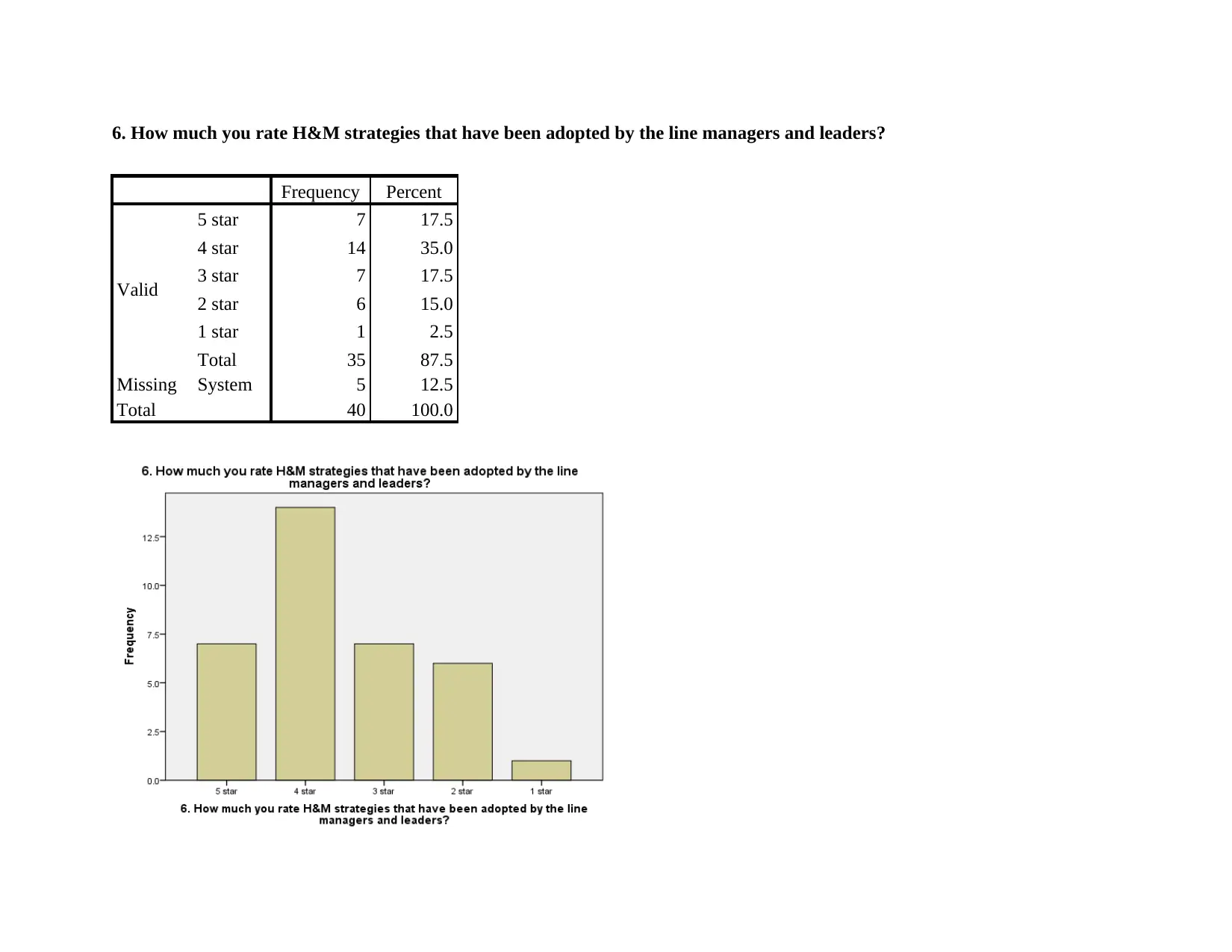
6. How much you rate H&M strategies that have been adopted by the line managers and leaders?
Frequency Percent
Valid
5 star 7 17.5
4 star 14 35.0
3 star 7 17.5
2 star 6 15.0
1 star 1 2.5
Total 35 87.5
Missing System 5 12.5
Total 40 100.0
Frequency Percent
Valid
5 star 7 17.5
4 star 14 35.0
3 star 7 17.5
2 star 6 15.0
1 star 1 2.5
Total 35 87.5
Missing System 5 12.5
Total 40 100.0
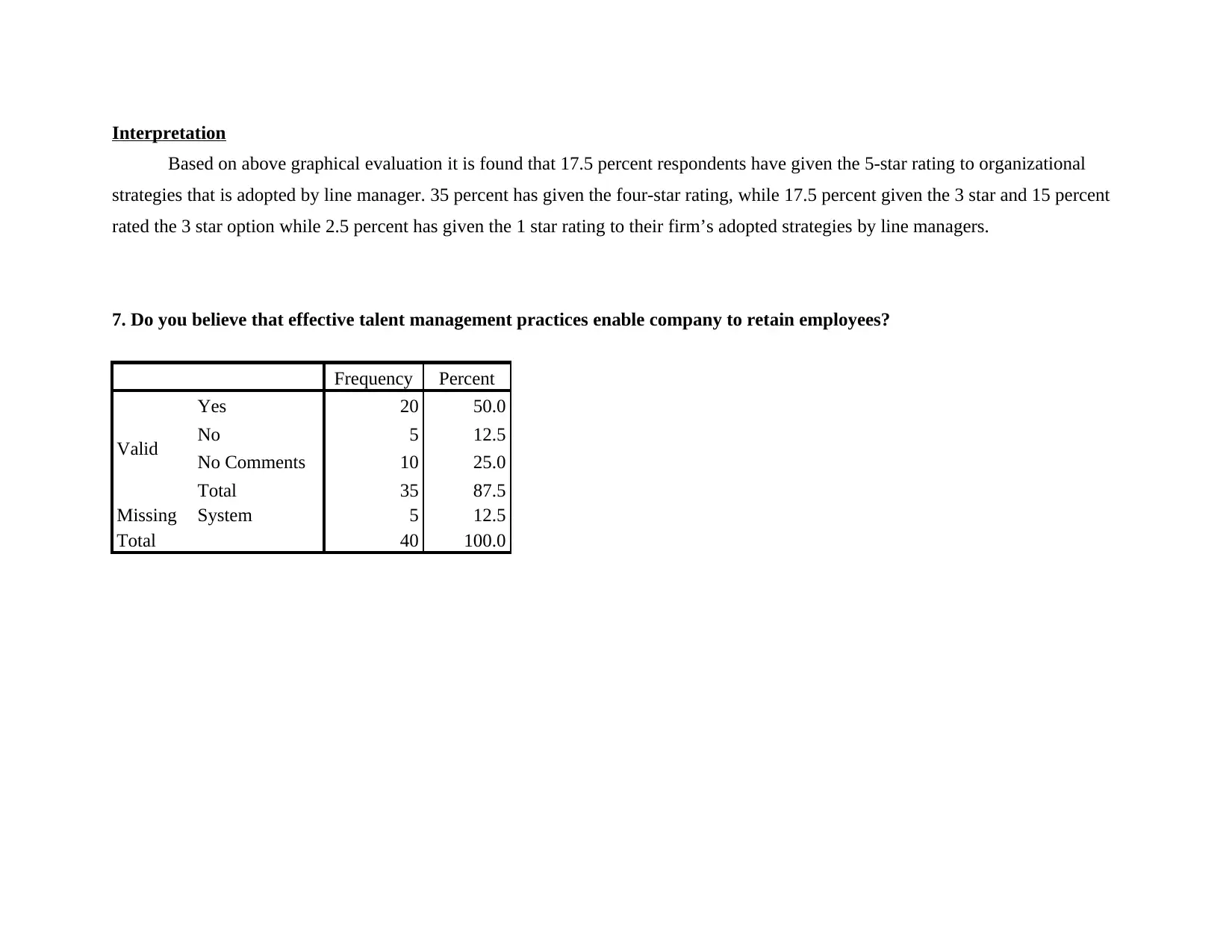
Interpretation
Based on above graphical evaluation it is found that 17.5 percent respondents have given the 5-star rating to organizational
strategies that is adopted by line manager. 35 percent has given the four-star rating, while 17.5 percent given the 3 star and 15 percent
rated the 3 star option while 2.5 percent has given the 1 star rating to their firm’s adopted strategies by line managers.
7. Do you believe that effective talent management practices enable company to retain employees?
Frequency Percent
Valid
Yes 20 50.0
No 5 12.5
No Comments 10 25.0
Total 35 87.5
Missing System 5 12.5
Total 40 100.0
Based on above graphical evaluation it is found that 17.5 percent respondents have given the 5-star rating to organizational
strategies that is adopted by line manager. 35 percent has given the four-star rating, while 17.5 percent given the 3 star and 15 percent
rated the 3 star option while 2.5 percent has given the 1 star rating to their firm’s adopted strategies by line managers.
7. Do you believe that effective talent management practices enable company to retain employees?
Frequency Percent
Valid
Yes 20 50.0
No 5 12.5
No Comments 10 25.0
Total 35 87.5
Missing System 5 12.5
Total 40 100.0
Secure Best Marks with AI Grader
Need help grading? Try our AI Grader for instant feedback on your assignments.
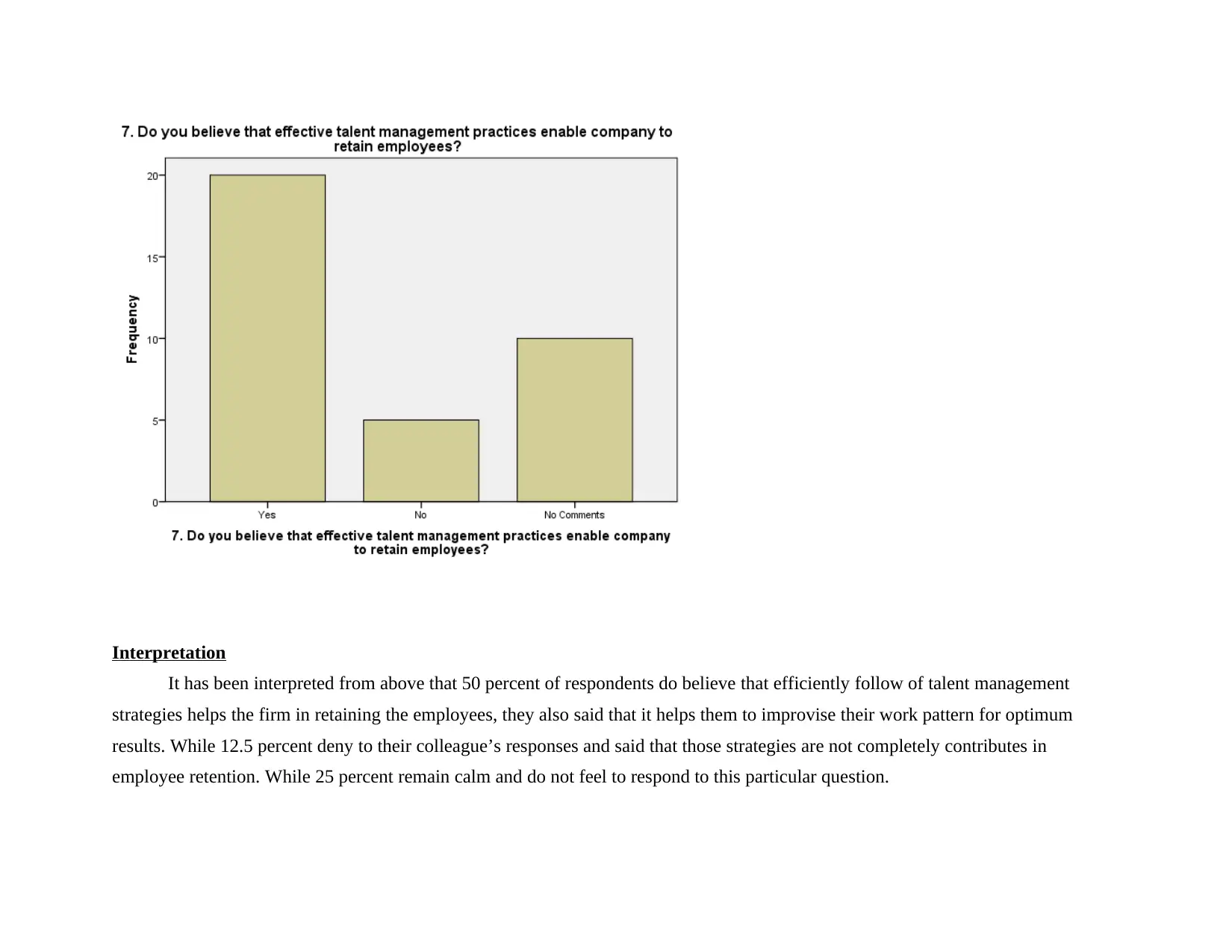
Interpretation
It has been interpreted from above that 50 percent of respondents do believe that efficiently follow of talent management
strategies helps the firm in retaining the employees, they also said that it helps them to improvise their work pattern for optimum
results. While 12.5 percent deny to their colleague’s responses and said that those strategies are not completely contributes in
employee retention. While 25 percent remain calm and do not feel to respond to this particular question.
It has been interpreted from above that 50 percent of respondents do believe that efficiently follow of talent management
strategies helps the firm in retaining the employees, they also said that it helps them to improvise their work pattern for optimum
results. While 12.5 percent deny to their colleague’s responses and said that those strategies are not completely contributes in
employee retention. While 25 percent remain calm and do not feel to respond to this particular question.
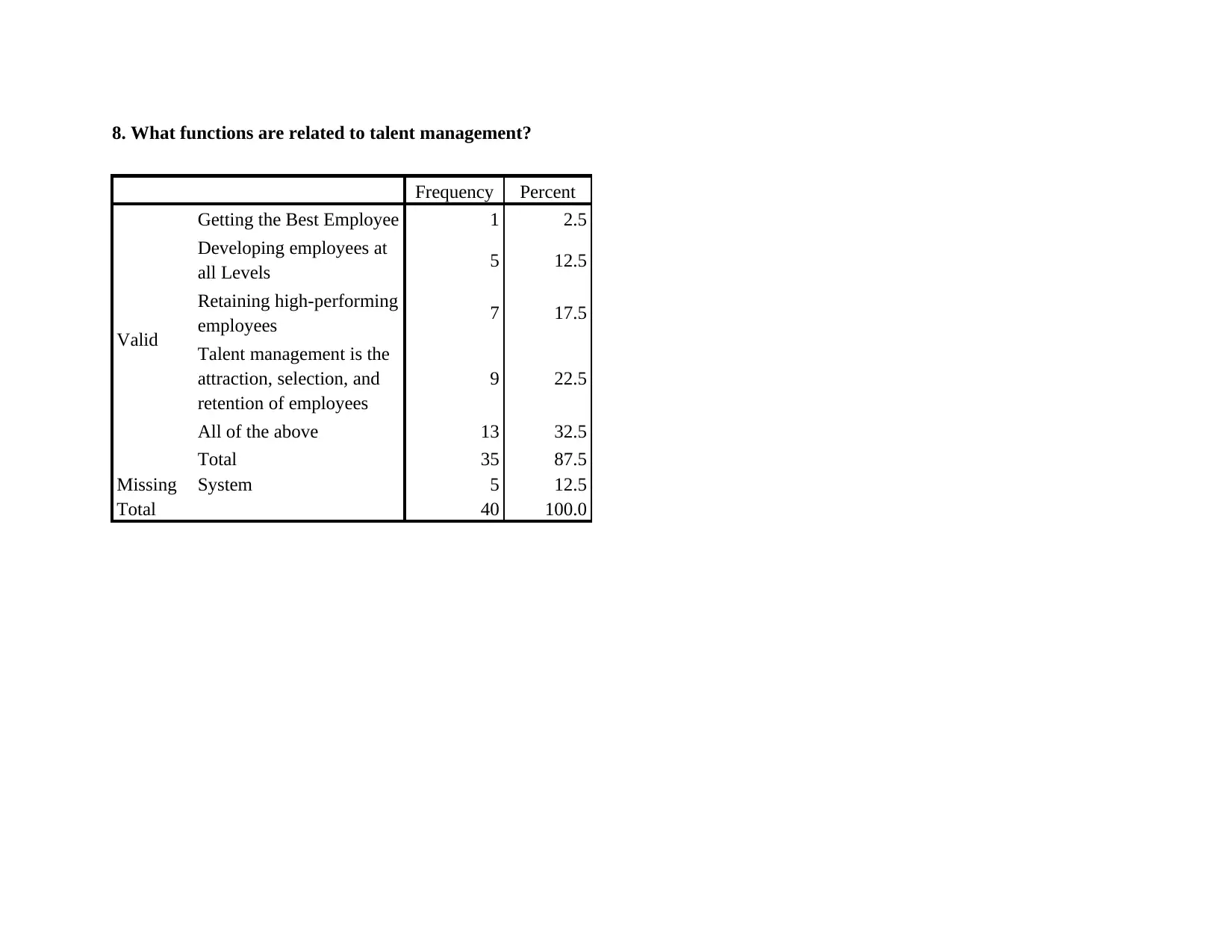
8. What functions are related to talent management?
Frequency Percent
Valid
Getting the Best Employee 1 2.5
Developing employees at
all Levels 5 12.5
Retaining high-performing
employees 7 17.5
Talent management is the
attraction, selection, and
retention of employees
9 22.5
All of the above 13 32.5
Total 35 87.5
Missing System 5 12.5
Total 40 100.0
Frequency Percent
Valid
Getting the Best Employee 1 2.5
Developing employees at
all Levels 5 12.5
Retaining high-performing
employees 7 17.5
Talent management is the
attraction, selection, and
retention of employees
9 22.5
All of the above 13 32.5
Total 35 87.5
Missing System 5 12.5
Total 40 100.0
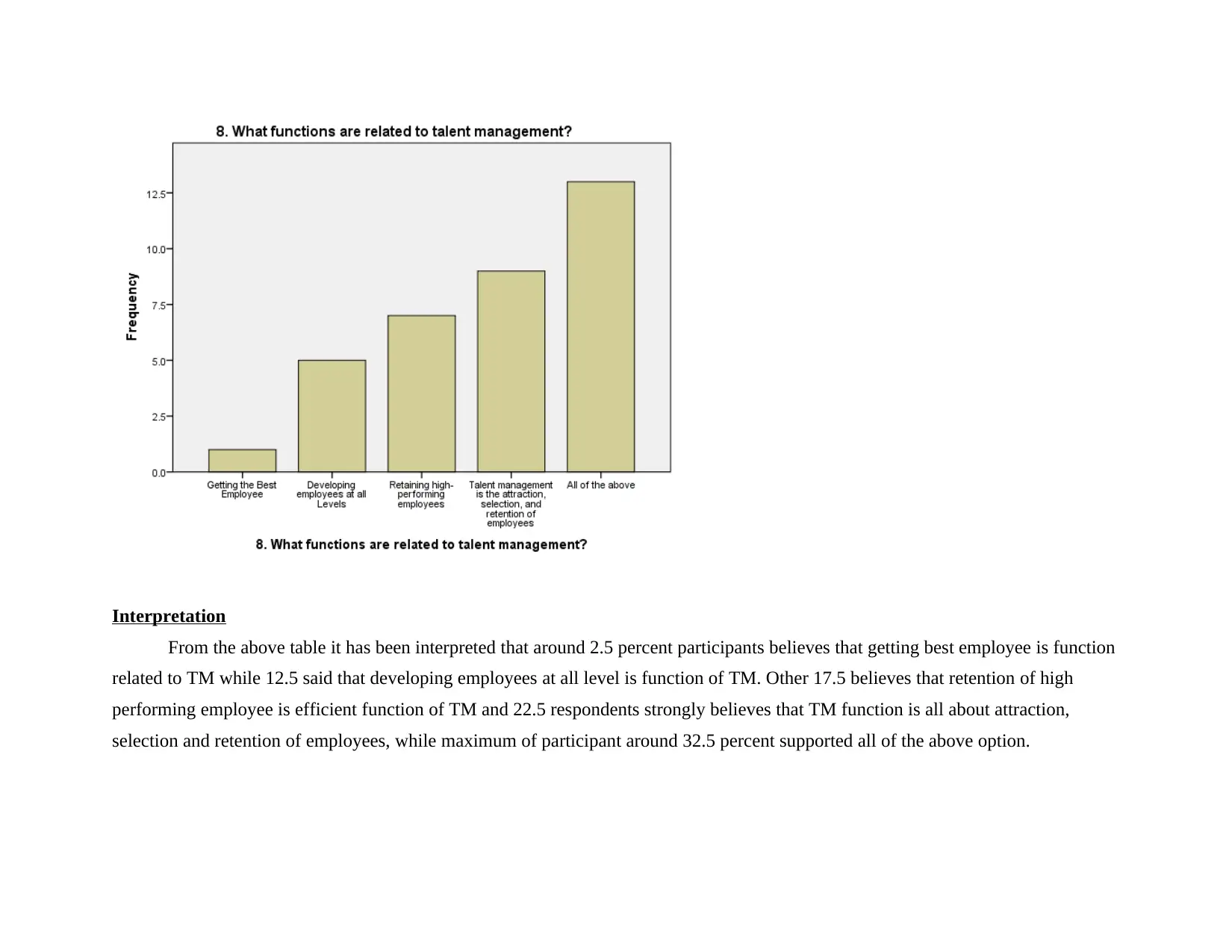
Interpretation
From the above table it has been interpreted that around 2.5 percent participants believes that getting best employee is function
related to TM while 12.5 said that developing employees at all level is function of TM. Other 17.5 believes that retention of high
performing employee is efficient function of TM and 22.5 respondents strongly believes that TM function is all about attraction,
selection and retention of employees, while maximum of participant around 32.5 percent supported all of the above option.
From the above table it has been interpreted that around 2.5 percent participants believes that getting best employee is function
related to TM while 12.5 said that developing employees at all level is function of TM. Other 17.5 believes that retention of high
performing employee is efficient function of TM and 22.5 respondents strongly believes that TM function is all about attraction,
selection and retention of employees, while maximum of participant around 32.5 percent supported all of the above option.
Paraphrase This Document
Need a fresh take? Get an instant paraphrase of this document with our AI Paraphraser
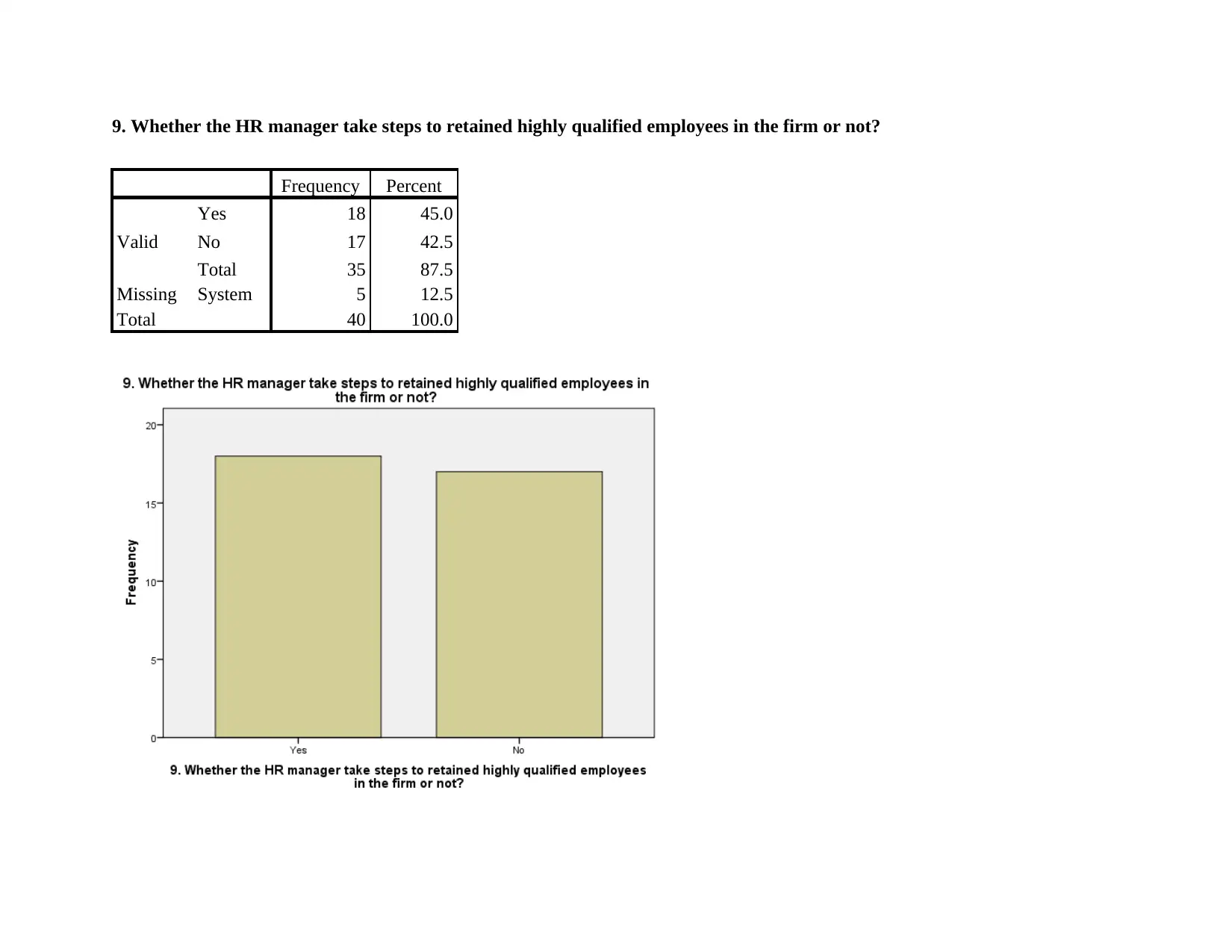
9. Whether the HR manager take steps to retained highly qualified employees in the firm or not?
Frequency Percent
Valid
Yes 18 45.0
No 17 42.5
Total 35 87.5
Missing System 5 12.5
Total 40 100.0
Frequency Percent
Valid
Yes 18 45.0
No 17 42.5
Total 35 87.5
Missing System 5 12.5
Total 40 100.0
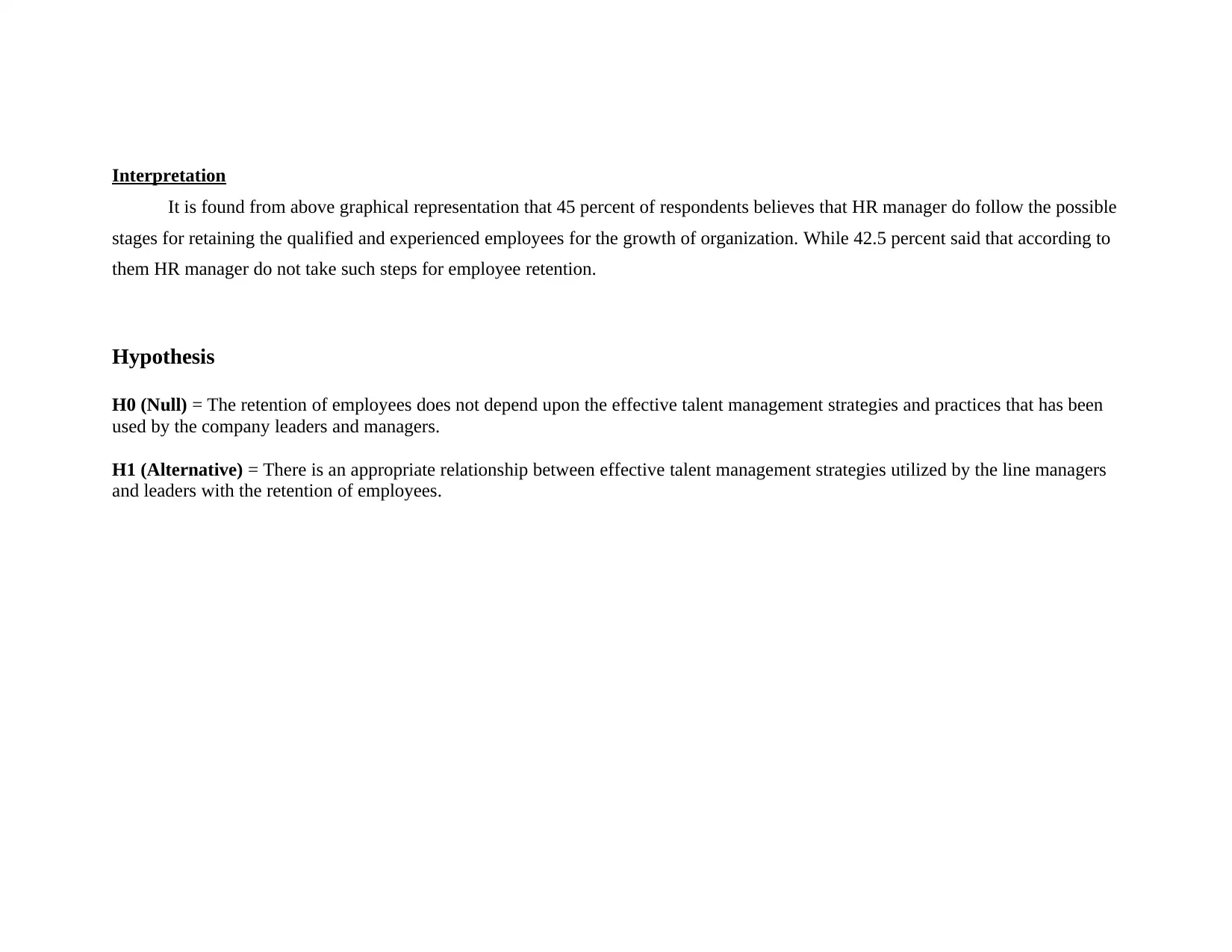
Interpretation
It is found from above graphical representation that 45 percent of respondents believes that HR manager do follow the possible
stages for retaining the qualified and experienced employees for the growth of organization. While 42.5 percent said that according to
them HR manager do not take such steps for employee retention.
Hypothesis
H0 (Null) = The retention of employees does not depend upon the effective talent management strategies and practices that has been
used by the company leaders and managers.
H1 (Alternative) = There is an appropriate relationship between effective talent management strategies utilized by the line managers
and leaders with the retention of employees.
It is found from above graphical representation that 45 percent of respondents believes that HR manager do follow the possible
stages for retaining the qualified and experienced employees for the growth of organization. While 42.5 percent said that according to
them HR manager do not take such steps for employee retention.
Hypothesis
H0 (Null) = The retention of employees does not depend upon the effective talent management strategies and practices that has been
used by the company leaders and managers.
H1 (Alternative) = There is an appropriate relationship between effective talent management strategies utilized by the line managers
and leaders with the retention of employees.
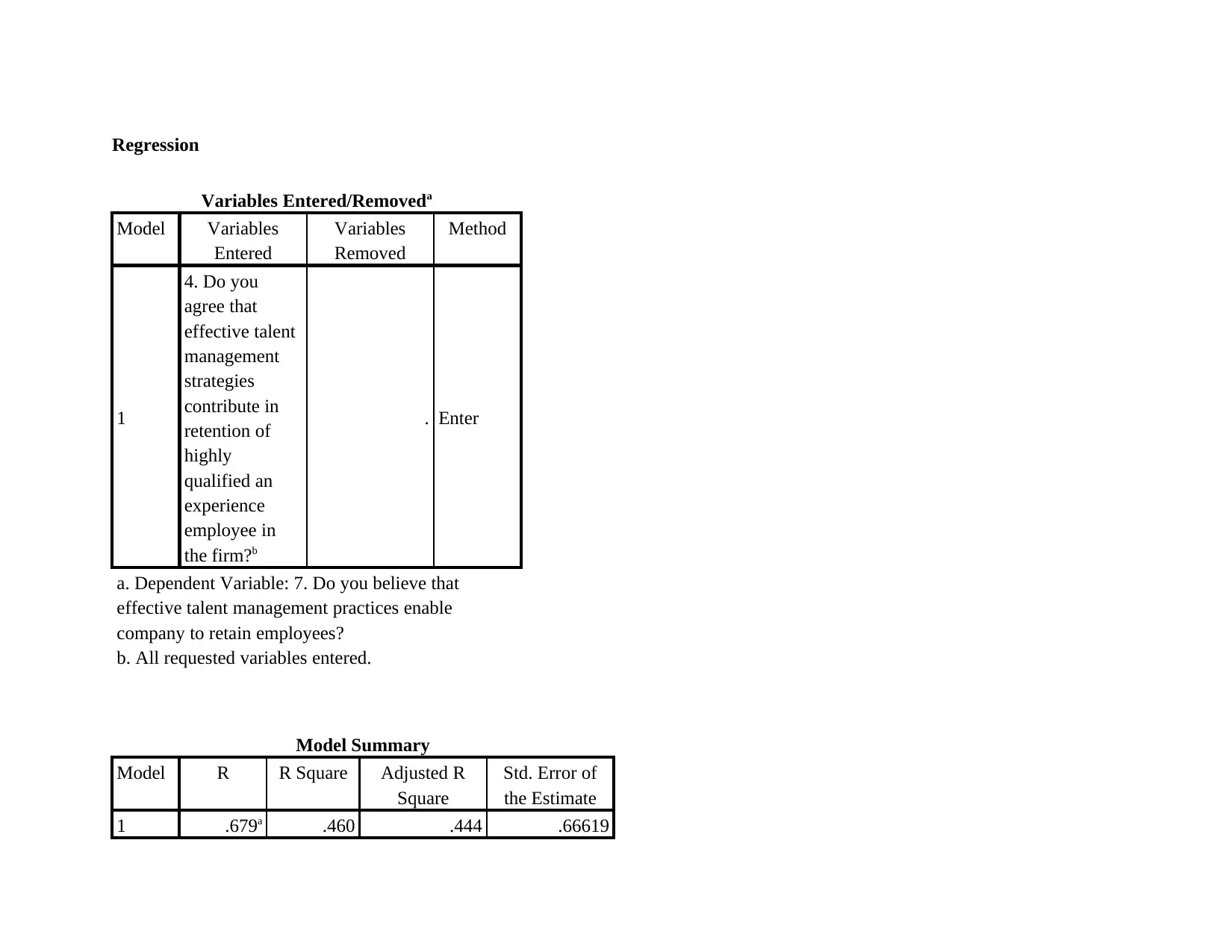
Regression
Variables Entered/Removeda
Model Variables
Entered
Variables
Removed
Method
1
4. Do you
agree that
effective talent
management
strategies
contribute in
retention of
highly
qualified an
experience
employee in
the firm?b
. Enter
a. Dependent Variable: 7. Do you believe that
effective talent management practices enable
company to retain employees?
b. All requested variables entered.
Model Summary
Model R R Square Adjusted R
Square
Std. Error of
the Estimate
1 .679a .460 .444 .66619
Variables Entered/Removeda
Model Variables
Entered
Variables
Removed
Method
1
4. Do you
agree that
effective talent
management
strategies
contribute in
retention of
highly
qualified an
experience
employee in
the firm?b
. Enter
a. Dependent Variable: 7. Do you believe that
effective talent management practices enable
company to retain employees?
b. All requested variables entered.
Model Summary
Model R R Square Adjusted R
Square
Std. Error of
the Estimate
1 .679a .460 .444 .66619
Secure Best Marks with AI Grader
Need help grading? Try our AI Grader for instant feedback on your assignments.
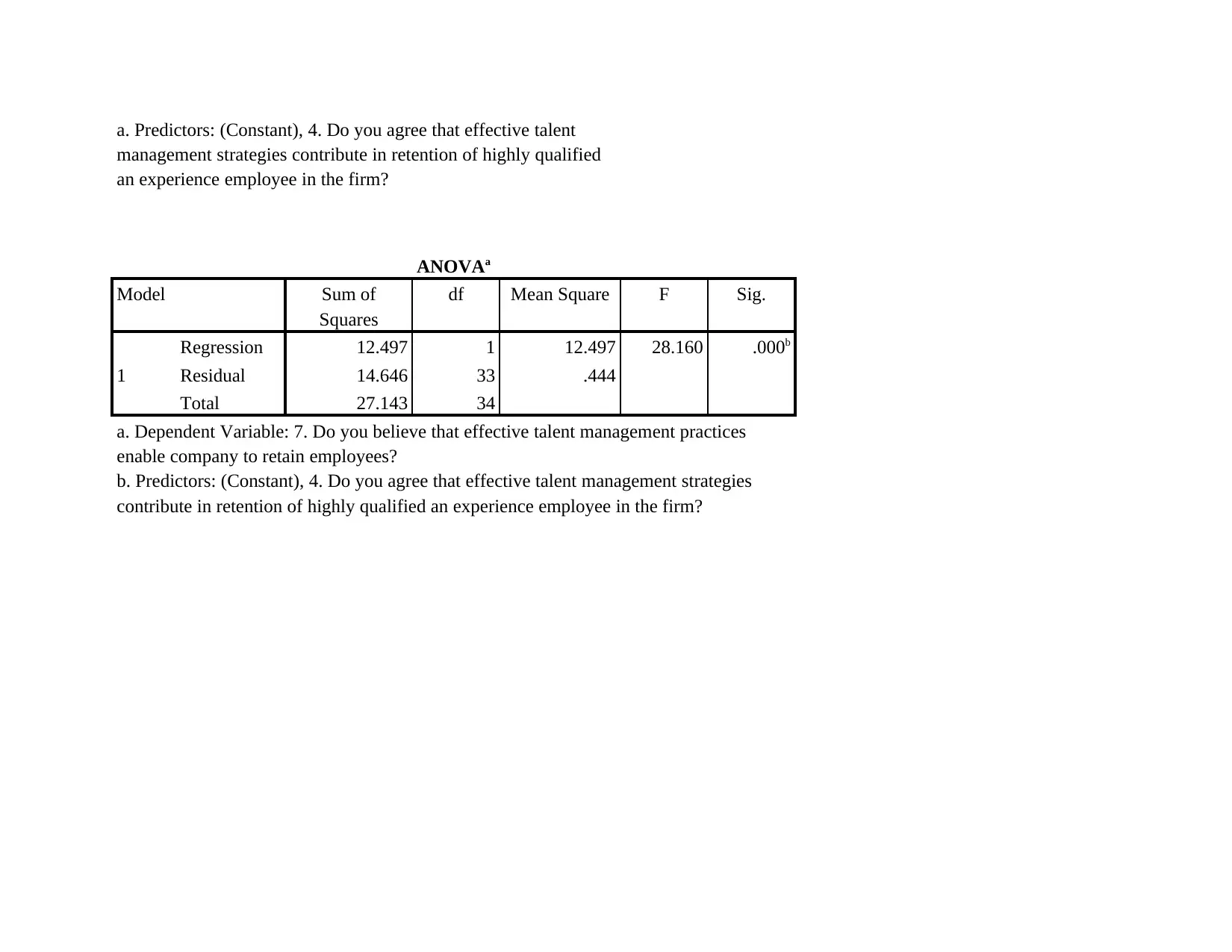
a. Predictors: (Constant), 4. Do you agree that effective talent
management strategies contribute in retention of highly qualified
an experience employee in the firm?
ANOVAa
Model Sum of
Squares
df Mean Square F Sig.
1
Regression 12.497 1 12.497 28.160 .000b
Residual 14.646 33 .444
Total 27.143 34
a. Dependent Variable: 7. Do you believe that effective talent management practices
enable company to retain employees?
b. Predictors: (Constant), 4. Do you agree that effective talent management strategies
contribute in retention of highly qualified an experience employee in the firm?
management strategies contribute in retention of highly qualified
an experience employee in the firm?
ANOVAa
Model Sum of
Squares
df Mean Square F Sig.
1
Regression 12.497 1 12.497 28.160 .000b
Residual 14.646 33 .444
Total 27.143 34
a. Dependent Variable: 7. Do you believe that effective talent management practices
enable company to retain employees?
b. Predictors: (Constant), 4. Do you agree that effective talent management strategies
contribute in retention of highly qualified an experience employee in the firm?
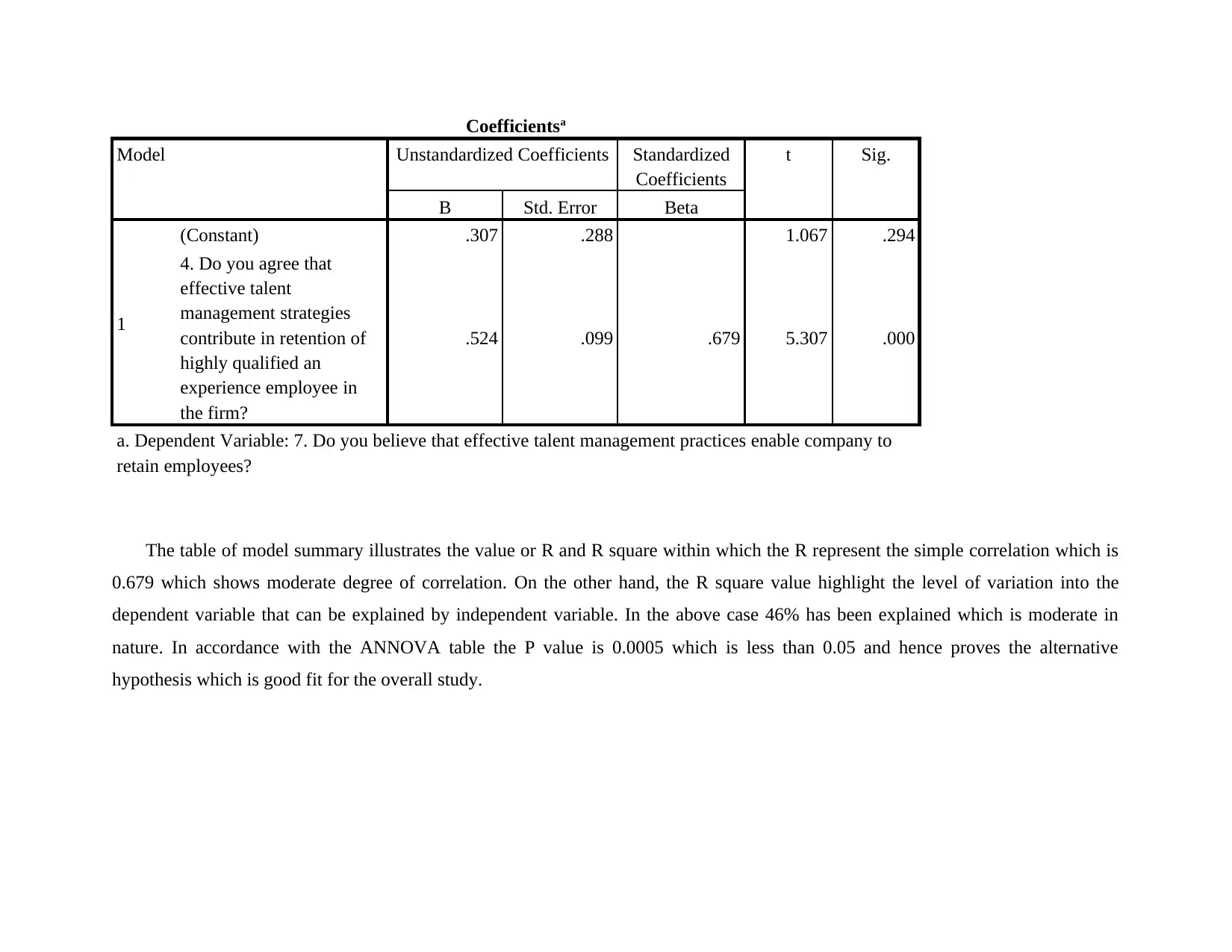
Coefficientsa
Model Unstandardized Coefficients Standardized
Coefficients
t Sig.
B Std. Error Beta
1
(Constant) .307 .288 1.067 .294
4. Do you agree that
effective talent
management strategies
contribute in retention of
highly qualified an
experience employee in
the firm?
.524 .099 .679 5.307 .000
a. Dependent Variable: 7. Do you believe that effective talent management practices enable company to
retain employees?
The table of model summary illustrates the value or R and R square within which the R represent the simple correlation which is
0.679 which shows moderate degree of correlation. On the other hand, the R square value highlight the level of variation into the
dependent variable that can be explained by independent variable. In the above case 46% has been explained which is moderate in
nature. In accordance with the ANNOVA table the P value is 0.0005 which is less than 0.05 and hence proves the alternative
hypothesis which is good fit for the overall study.
Model Unstandardized Coefficients Standardized
Coefficients
t Sig.
B Std. Error Beta
1
(Constant) .307 .288 1.067 .294
4. Do you agree that
effective talent
management strategies
contribute in retention of
highly qualified an
experience employee in
the firm?
.524 .099 .679 5.307 .000
a. Dependent Variable: 7. Do you believe that effective talent management practices enable company to
retain employees?
The table of model summary illustrates the value or R and R square within which the R represent the simple correlation which is
0.679 which shows moderate degree of correlation. On the other hand, the R square value highlight the level of variation into the
dependent variable that can be explained by independent variable. In the above case 46% has been explained which is moderate in
nature. In accordance with the ANNOVA table the P value is 0.0005 which is less than 0.05 and hence proves the alternative
hypothesis which is good fit for the overall study.
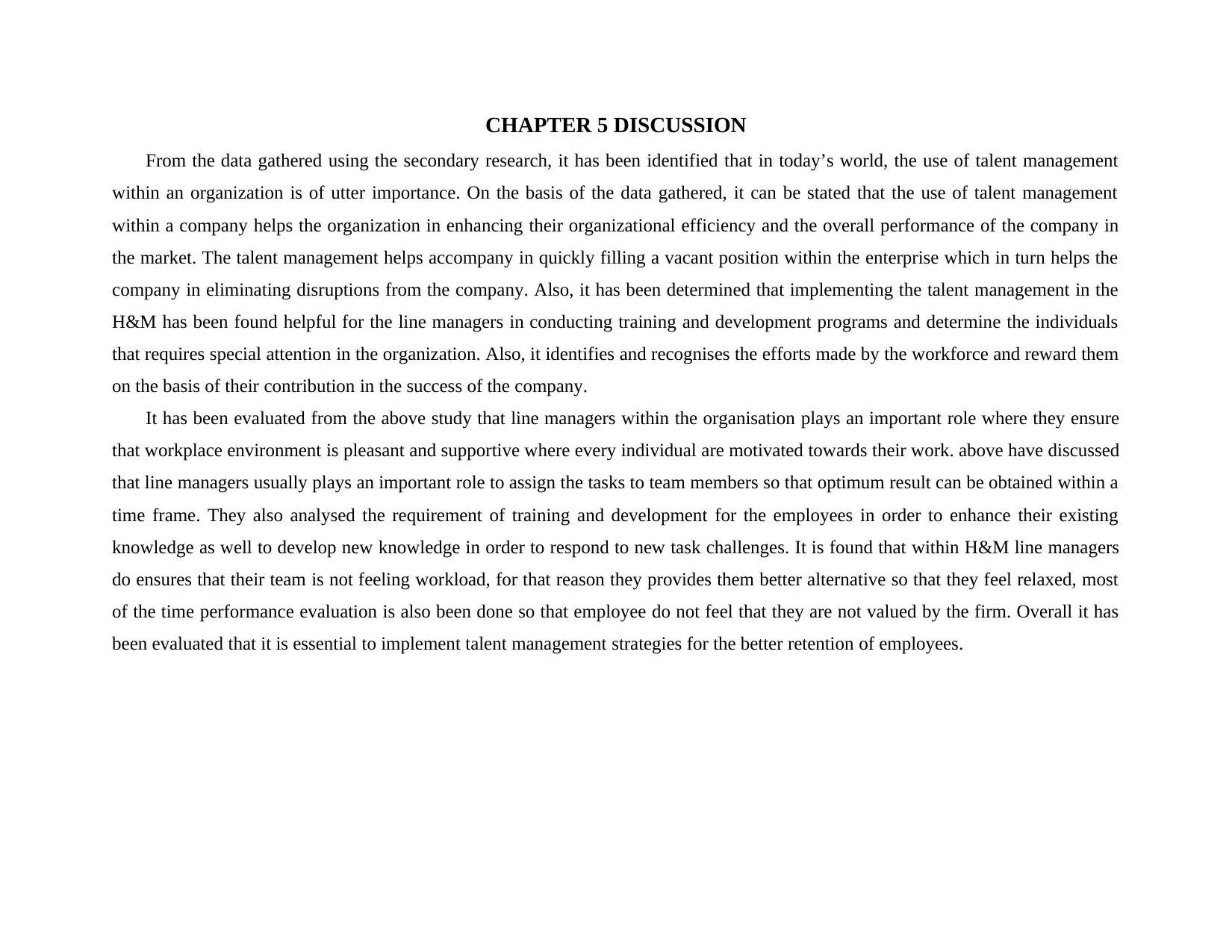
CHAPTER 5 DISCUSSION
From the data gathered using the secondary research, it has been identified that in today’s world, the use of talent management
within an organization is of utter importance. On the basis of the data gathered, it can be stated that the use of talent management
within a company helps the organization in enhancing their organizational efficiency and the overall performance of the company in
the market. The talent management helps accompany in quickly filling a vacant position within the enterprise which in turn helps the
company in eliminating disruptions from the company. Also, it has been determined that implementing the talent management in the
H&M has been found helpful for the line managers in conducting training and development programs and determine the individuals
that requires special attention in the organization. Also, it identifies and recognises the efforts made by the workforce and reward them
on the basis of their contribution in the success of the company.
It has been evaluated from the above study that line managers within the organisation plays an important role where they ensure
that workplace environment is pleasant and supportive where every individual are motivated towards their work. above have discussed
that line managers usually plays an important role to assign the tasks to team members so that optimum result can be obtained within a
time frame. They also analysed the requirement of training and development for the employees in order to enhance their existing
knowledge as well to develop new knowledge in order to respond to new task challenges. It is found that within H&M line managers
do ensures that their team is not feeling workload, for that reason they provides them better alternative so that they feel relaxed, most
of the time performance evaluation is also been done so that employee do not feel that they are not valued by the firm. Overall it has
been evaluated that it is essential to implement talent management strategies for the better retention of employees.
From the data gathered using the secondary research, it has been identified that in today’s world, the use of talent management
within an organization is of utter importance. On the basis of the data gathered, it can be stated that the use of talent management
within a company helps the organization in enhancing their organizational efficiency and the overall performance of the company in
the market. The talent management helps accompany in quickly filling a vacant position within the enterprise which in turn helps the
company in eliminating disruptions from the company. Also, it has been determined that implementing the talent management in the
H&M has been found helpful for the line managers in conducting training and development programs and determine the individuals
that requires special attention in the organization. Also, it identifies and recognises the efforts made by the workforce and reward them
on the basis of their contribution in the success of the company.
It has been evaluated from the above study that line managers within the organisation plays an important role where they ensure
that workplace environment is pleasant and supportive where every individual are motivated towards their work. above have discussed
that line managers usually plays an important role to assign the tasks to team members so that optimum result can be obtained within a
time frame. They also analysed the requirement of training and development for the employees in order to enhance their existing
knowledge as well to develop new knowledge in order to respond to new task challenges. It is found that within H&M line managers
do ensures that their team is not feeling workload, for that reason they provides them better alternative so that they feel relaxed, most
of the time performance evaluation is also been done so that employee do not feel that they are not valued by the firm. Overall it has
been evaluated that it is essential to implement talent management strategies for the better retention of employees.
Paraphrase This Document
Need a fresh take? Get an instant paraphrase of this document with our AI Paraphraser
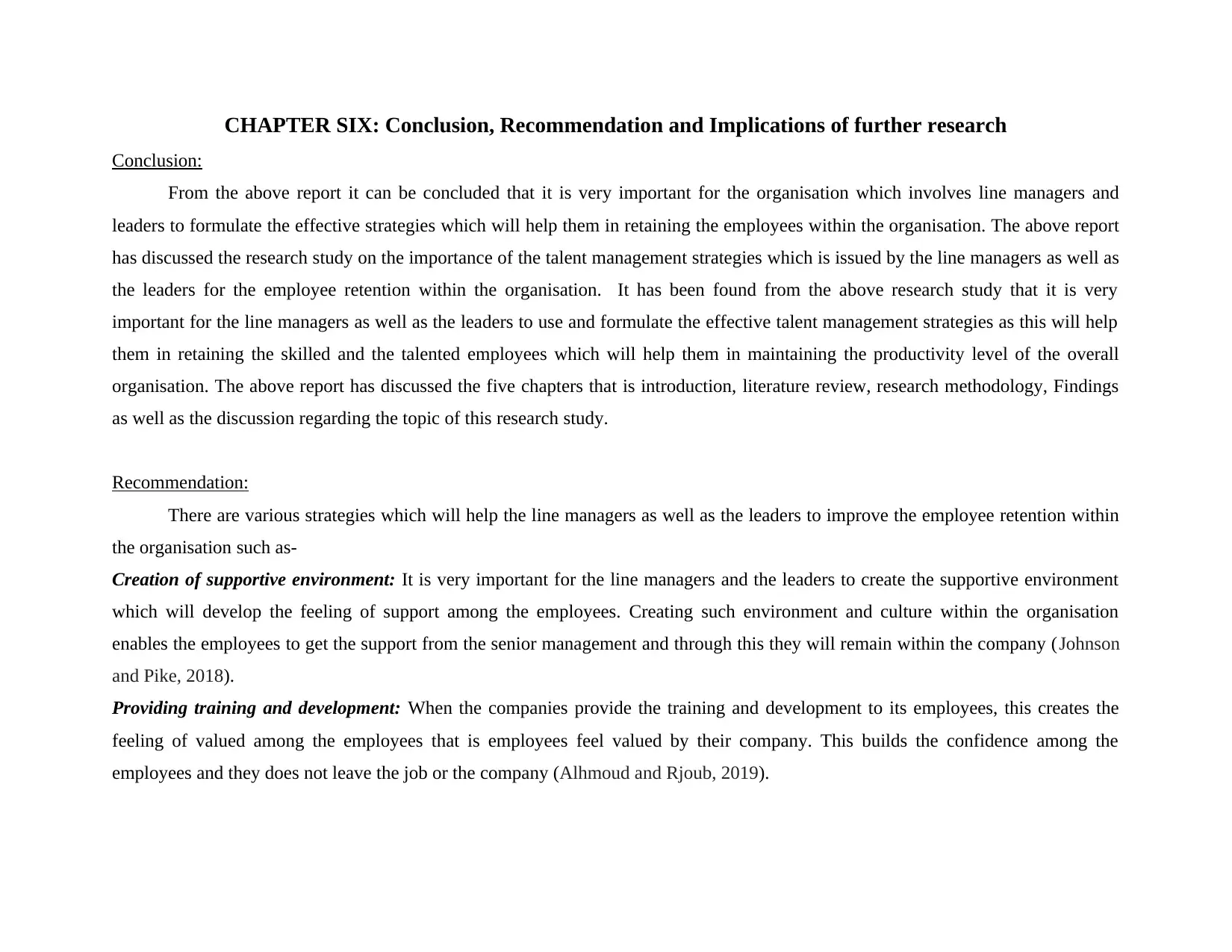
CHAPTER SIX: Conclusion, Recommendation and Implications of further research
Conclusion:
From the above report it can be concluded that it is very important for the organisation which involves line managers and
leaders to formulate the effective strategies which will help them in retaining the employees within the organisation. The above report
has discussed the research study on the importance of the talent management strategies which is issued by the line managers as well as
the leaders for the employee retention within the organisation. It has been found from the above research study that it is very
important for the line managers as well as the leaders to use and formulate the effective talent management strategies as this will help
them in retaining the skilled and the talented employees which will help them in maintaining the productivity level of the overall
organisation. The above report has discussed the five chapters that is introduction, literature review, research methodology, Findings
as well as the discussion regarding the topic of this research study.
Recommendation:
There are various strategies which will help the line managers as well as the leaders to improve the employee retention within
the organisation such as-
Creation of supportive environment: It is very important for the line managers and the leaders to create the supportive environment
which will develop the feeling of support among the employees. Creating such environment and culture within the organisation
enables the employees to get the support from the senior management and through this they will remain within the company (Johnson
and Pike, 2018).
Providing training and development: When the companies provide the training and development to its employees, this creates the
feeling of valued among the employees that is employees feel valued by their company. This builds the confidence among the
employees and they does not leave the job or the company (Alhmoud and Rjoub, 2019).
Conclusion:
From the above report it can be concluded that it is very important for the organisation which involves line managers and
leaders to formulate the effective strategies which will help them in retaining the employees within the organisation. The above report
has discussed the research study on the importance of the talent management strategies which is issued by the line managers as well as
the leaders for the employee retention within the organisation. It has been found from the above research study that it is very
important for the line managers as well as the leaders to use and formulate the effective talent management strategies as this will help
them in retaining the skilled and the talented employees which will help them in maintaining the productivity level of the overall
organisation. The above report has discussed the five chapters that is introduction, literature review, research methodology, Findings
as well as the discussion regarding the topic of this research study.
Recommendation:
There are various strategies which will help the line managers as well as the leaders to improve the employee retention within
the organisation such as-
Creation of supportive environment: It is very important for the line managers and the leaders to create the supportive environment
which will develop the feeling of support among the employees. Creating such environment and culture within the organisation
enables the employees to get the support from the senior management and through this they will remain within the company (Johnson
and Pike, 2018).
Providing training and development: When the companies provide the training and development to its employees, this creates the
feeling of valued among the employees that is employees feel valued by their company. This builds the confidence among the
employees and they does not leave the job or the company (Alhmoud and Rjoub, 2019).
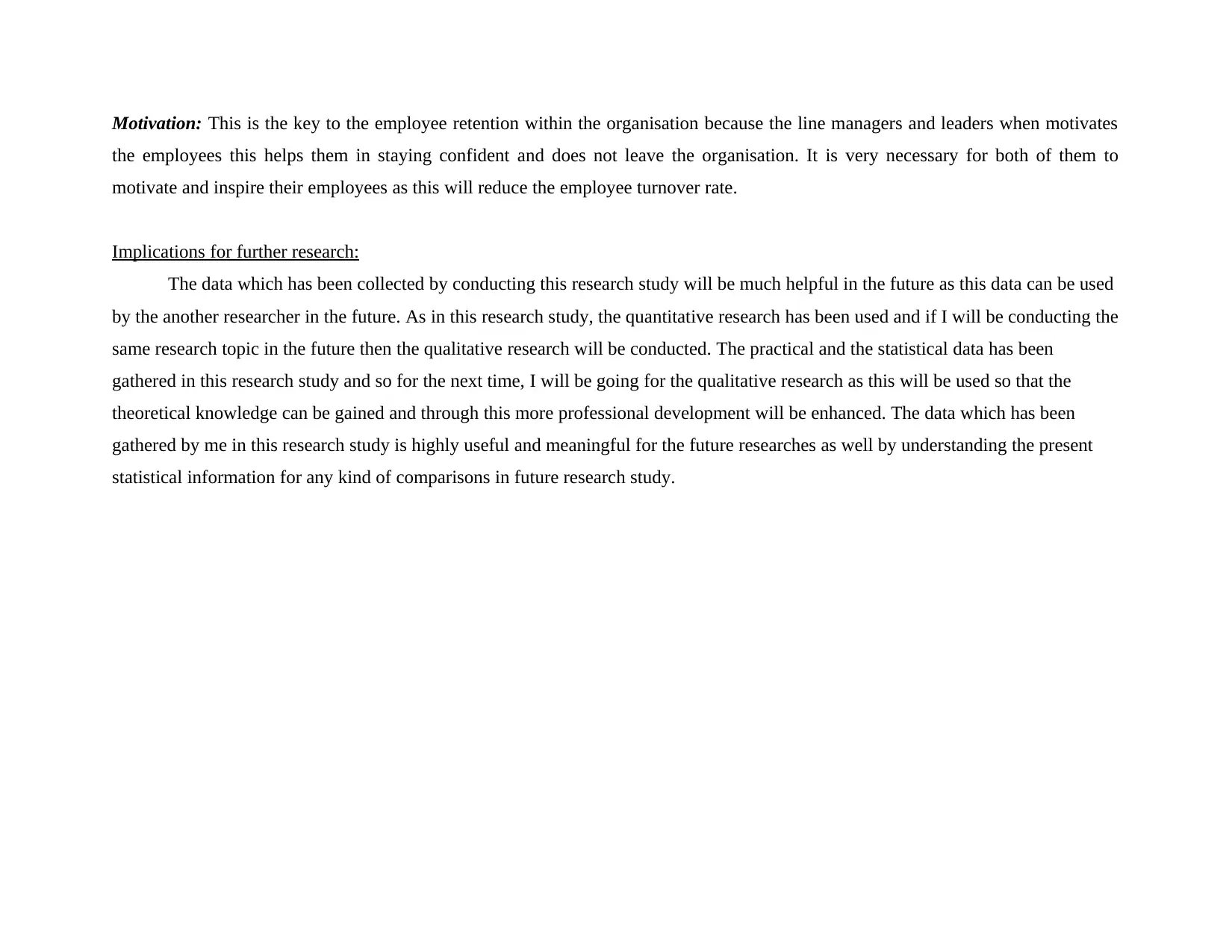
Motivation: This is the key to the employee retention within the organisation because the line managers and leaders when motivates
the employees this helps them in staying confident and does not leave the organisation. It is very necessary for both of them to
motivate and inspire their employees as this will reduce the employee turnover rate.
Implications for further research:
The data which has been collected by conducting this research study will be much helpful in the future as this data can be used
by the another researcher in the future. As in this research study, the quantitative research has been used and if I will be conducting the
same research topic in the future then the qualitative research will be conducted. The practical and the statistical data has been
gathered in this research study and so for the next time, I will be going for the qualitative research as this will be used so that the
theoretical knowledge can be gained and through this more professional development will be enhanced. The data which has been
gathered by me in this research study is highly useful and meaningful for the future researches as well by understanding the present
statistical information for any kind of comparisons in future research study.
the employees this helps them in staying confident and does not leave the organisation. It is very necessary for both of them to
motivate and inspire their employees as this will reduce the employee turnover rate.
Implications for further research:
The data which has been collected by conducting this research study will be much helpful in the future as this data can be used
by the another researcher in the future. As in this research study, the quantitative research has been used and if I will be conducting the
same research topic in the future then the qualitative research will be conducted. The practical and the statistical data has been
gathered in this research study and so for the next time, I will be going for the qualitative research as this will be used so that the
theoretical knowledge can be gained and through this more professional development will be enhanced. The data which has been
gathered by me in this research study is highly useful and meaningful for the future researches as well by understanding the present
statistical information for any kind of comparisons in future research study.

Secure Best Marks with AI Grader
Need help grading? Try our AI Grader for instant feedback on your assignments.
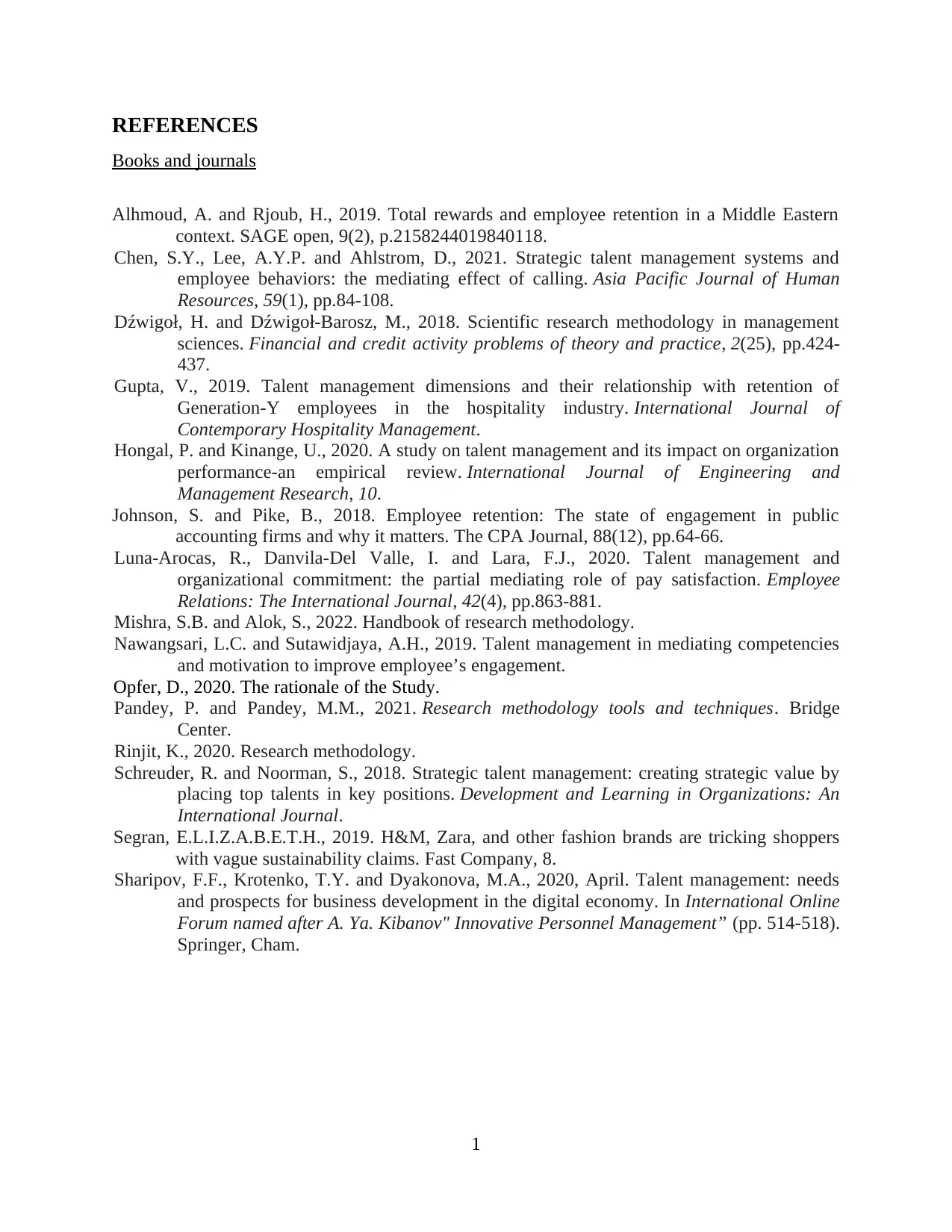
REFERENCES
Books and journals
Alhmoud, A. and Rjoub, H., 2019. Total rewards and employee retention in a Middle Eastern
context. SAGE open, 9(2), p.2158244019840118.
Chen, S.Y., Lee, A.Y.P. and Ahlstrom, D., 2021. Strategic talent management systems and
employee behaviors: the mediating effect of calling. Asia Pacific Journal of Human
Resources, 59(1), pp.84-108.
Dźwigoł, H. and Dźwigoł-Barosz, M., 2018. Scientific research methodology in management
sciences. Financial and credit activity problems of theory and practice, 2(25), pp.424-
437.
Gupta, V., 2019. Talent management dimensions and their relationship with retention of
Generation-Y employees in the hospitality industry. International Journal of
Contemporary Hospitality Management.
Hongal, P. and Kinange, U., 2020. A study on talent management and its impact on organization
performance-an empirical review. International Journal of Engineering and
Management Research, 10.
Johnson, S. and Pike, B., 2018. Employee retention: The state of engagement in public
accounting firms and why it matters. The CPA Journal, 88(12), pp.64-66.
Luna-Arocas, R., Danvila-Del Valle, I. and Lara, F.J., 2020. Talent management and
organizational commitment: the partial mediating role of pay satisfaction. Employee
Relations: The International Journal, 42(4), pp.863-881.
Mishra, S.B. and Alok, S., 2022. Handbook of research methodology.
Nawangsari, L.C. and Sutawidjaya, A.H., 2019. Talent management in mediating competencies
and motivation to improve employee’s engagement.
Opfer, D., 2020. The rationale of the Study.
Pandey, P. and Pandey, M.M., 2021. Research methodology tools and techniques. Bridge
Center.
Rinjit, K., 2020. Research methodology.
Schreuder, R. and Noorman, S., 2018. Strategic talent management: creating strategic value by
placing top talents in key positions. Development and Learning in Organizations: An
International Journal.
Segran, E.L.I.Z.A.B.E.T.H., 2019. H&M, Zara, and other fashion brands are tricking shoppers
with vague sustainability claims. Fast Company, 8.
Sharipov, F.F., Krotenko, T.Y. and Dyakonova, M.A., 2020, April. Talent management: needs
and prospects for business development in the digital economy. In International Online
Forum named after A. Ya. Kibanov" Innovative Personnel Management” (pp. 514-518).
Springer, Cham.
1
Books and journals
Alhmoud, A. and Rjoub, H., 2019. Total rewards and employee retention in a Middle Eastern
context. SAGE open, 9(2), p.2158244019840118.
Chen, S.Y., Lee, A.Y.P. and Ahlstrom, D., 2021. Strategic talent management systems and
employee behaviors: the mediating effect of calling. Asia Pacific Journal of Human
Resources, 59(1), pp.84-108.
Dźwigoł, H. and Dźwigoł-Barosz, M., 2018. Scientific research methodology in management
sciences. Financial and credit activity problems of theory and practice, 2(25), pp.424-
437.
Gupta, V., 2019. Talent management dimensions and their relationship with retention of
Generation-Y employees in the hospitality industry. International Journal of
Contemporary Hospitality Management.
Hongal, P. and Kinange, U., 2020. A study on talent management and its impact on organization
performance-an empirical review. International Journal of Engineering and
Management Research, 10.
Johnson, S. and Pike, B., 2018. Employee retention: The state of engagement in public
accounting firms and why it matters. The CPA Journal, 88(12), pp.64-66.
Luna-Arocas, R., Danvila-Del Valle, I. and Lara, F.J., 2020. Talent management and
organizational commitment: the partial mediating role of pay satisfaction. Employee
Relations: The International Journal, 42(4), pp.863-881.
Mishra, S.B. and Alok, S., 2022. Handbook of research methodology.
Nawangsari, L.C. and Sutawidjaya, A.H., 2019. Talent management in mediating competencies
and motivation to improve employee’s engagement.
Opfer, D., 2020. The rationale of the Study.
Pandey, P. and Pandey, M.M., 2021. Research methodology tools and techniques. Bridge
Center.
Rinjit, K., 2020. Research methodology.
Schreuder, R. and Noorman, S., 2018. Strategic talent management: creating strategic value by
placing top talents in key positions. Development and Learning in Organizations: An
International Journal.
Segran, E.L.I.Z.A.B.E.T.H., 2019. H&M, Zara, and other fashion brands are tricking shoppers
with vague sustainability claims. Fast Company, 8.
Sharipov, F.F., Krotenko, T.Y. and Dyakonova, M.A., 2020, April. Talent management: needs
and prospects for business development in the digital economy. In International Online
Forum named after A. Ya. Kibanov" Innovative Personnel Management” (pp. 514-518).
Springer, Cham.
1
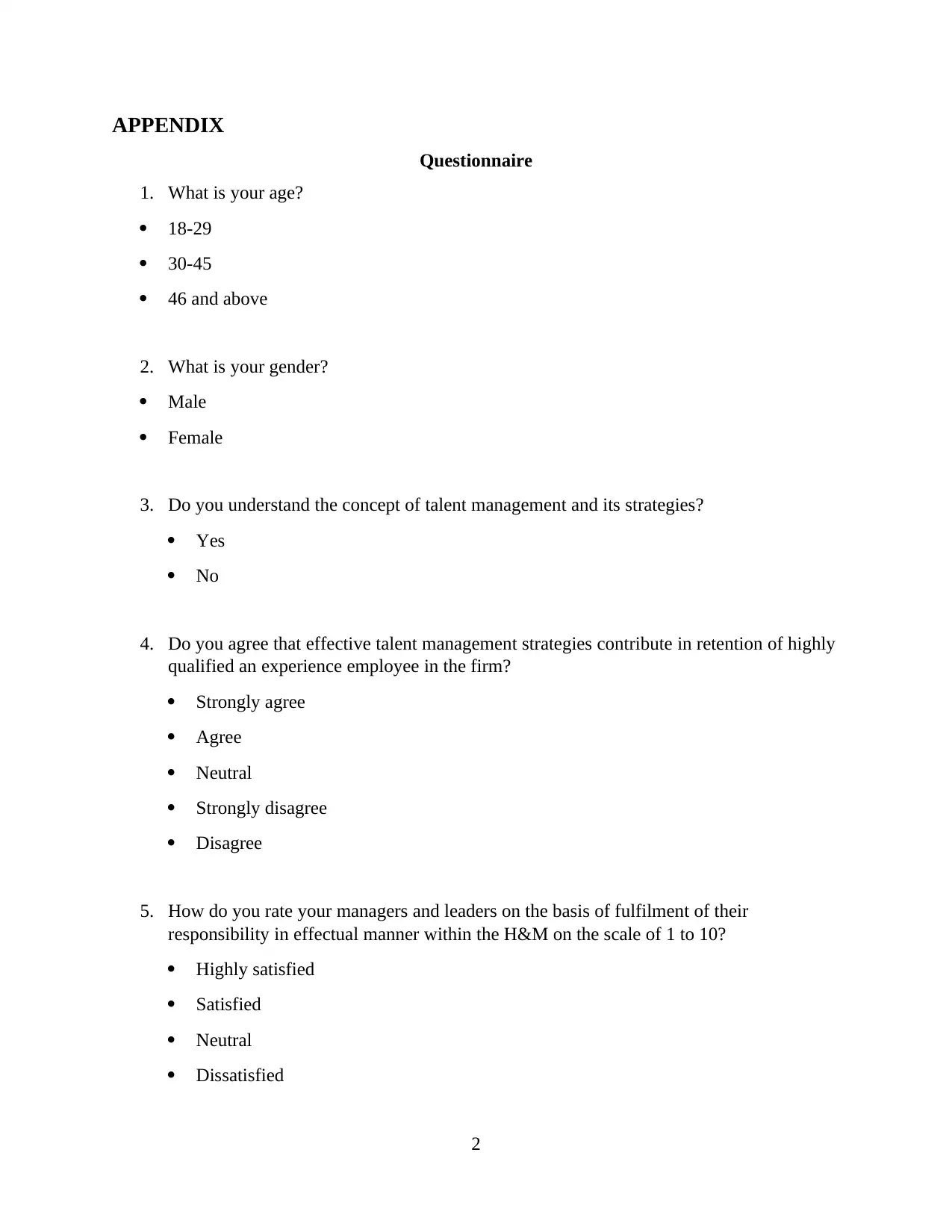
APPENDIX
Questionnaire
1. What is your age?
18-29
30-45
46 and above
2. What is your gender?
Male
Female
3. Do you understand the concept of talent management and its strategies?
Yes
No
4. Do you agree that effective talent management strategies contribute in retention of highly
qualified an experience employee in the firm?
Strongly agree
Agree
Neutral
Strongly disagree
Disagree
5. How do you rate your managers and leaders on the basis of fulfilment of their
responsibility in effectual manner within the H&M on the scale of 1 to 10?
Highly satisfied
Satisfied
Neutral
Dissatisfied
2
Questionnaire
1. What is your age?
18-29
30-45
46 and above
2. What is your gender?
Male
Female
3. Do you understand the concept of talent management and its strategies?
Yes
No
4. Do you agree that effective talent management strategies contribute in retention of highly
qualified an experience employee in the firm?
Strongly agree
Agree
Neutral
Strongly disagree
Disagree
5. How do you rate your managers and leaders on the basis of fulfilment of their
responsibility in effectual manner within the H&M on the scale of 1 to 10?
Highly satisfied
Satisfied
Neutral
Dissatisfied
2
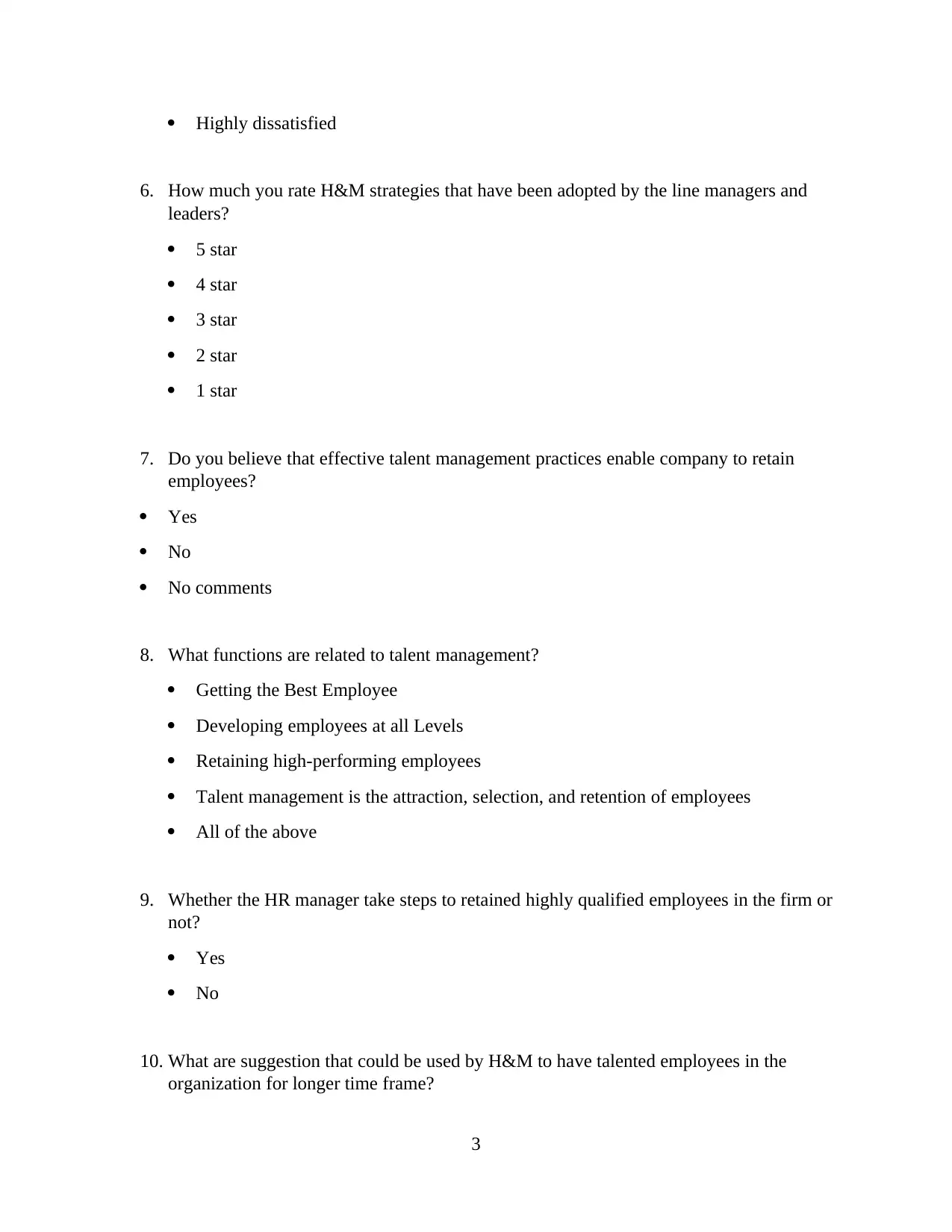
Highly dissatisfied
6. How much you rate H&M strategies that have been adopted by the line managers and
leaders?
5 star
4 star
3 star
2 star
1 star
7. Do you believe that effective talent management practices enable company to retain
employees?
Yes
No
No comments
8. What functions are related to talent management?
Getting the Best Employee
Developing employees at all Levels
Retaining high-performing employees
Talent management is the attraction, selection, and retention of employees
All of the above
9. Whether the HR manager take steps to retained highly qualified employees in the firm or
not?
Yes
No
10. What are suggestion that could be used by H&M to have talented employees in the
organization for longer time frame?
3
6. How much you rate H&M strategies that have been adopted by the line managers and
leaders?
5 star
4 star
3 star
2 star
1 star
7. Do you believe that effective talent management practices enable company to retain
employees?
Yes
No
No comments
8. What functions are related to talent management?
Getting the Best Employee
Developing employees at all Levels
Retaining high-performing employees
Talent management is the attraction, selection, and retention of employees
All of the above
9. Whether the HR manager take steps to retained highly qualified employees in the firm or
not?
Yes
No
10. What are suggestion that could be used by H&M to have talented employees in the
organization for longer time frame?
3
Paraphrase This Document
Need a fresh take? Get an instant paraphrase of this document with our AI Paraphraser

4
1 out of 38
Related Documents
Your All-in-One AI-Powered Toolkit for Academic Success.
+13062052269
info@desklib.com
Available 24*7 on WhatsApp / Email
![[object Object]](/_next/static/media/star-bottom.7253800d.svg)
Unlock your academic potential
© 2024 | Zucol Services PVT LTD | All rights reserved.





